- A Guide To The Most...

A Guide to the Most Beautiful Green Spaces in Moscow

Home to more parks than any other city in Russia , Moscow offers a cornucopia of choice when it comes to green spaces. From innovative wild urbanism to 18th-century royal estates, here are the best places to escape from the city buzz in Russia’s capital.
Spread over a territory of almost 300 acres, Gorky Park is Moscow’s most popular green space. Opened in 1928, it was designed as ‘a city inside a city’ with its own telegraph, police unit and a doctor’s office. Some 90 years later, Gorky Park offers everything from segway rides to an open-air movie theatre, through to illuminating lectures and fantastic dining spots.
9 Krimsky Val, Moscow, Russia , +7 495 995 00 20

As the name implies, Muzeon is perfect for art lovers. The park plays host to art fairs, exhibitions, music festivals and video performances. But even if you don’t care for art, Muzeon has a lot to offer: from an elegant boardwalk to hip coffee shops to an in-ground fountain, where you can actually cool off in summer.
2 Krimsky Val, Moscow, Russia , +7 985 382 27 32

Hermitage Garden
Opened in 1894, the Hermitage garden is a lovely compact park, nestled between high rise buildings in Moscow center. Home to theaters New Opera, Hermitage and Sphera, the garden is predictably crowded, with theatre-goers along with office workers from the business centres in Tverskaya – all flock here for a green respite.
3 Karetnyy Ryad, Moscow, Russia , +7 495 699 04 32
Sokolniki Park
An open-air cinema, a rope course, amusement park, bike rentals and more – Sokolniki is 1,275 acres of fun. In winter the whole park turns into one of Moscow’s most famous skating rinks. Sokolniki gradually blends into Losiny Ostrov National Park – the world’s third largest forest in a city.
1 Sokol’nicheskiy Val, bld. 1, Moscow, Russia , +7 499 393 92 22
Izmailovsky Park
Moscow’s biggest park, Izmailovsky stretches for almost 3,800 acres. Particularly favored by hikers and cyclists, the forest-like park is a popular family spot, equipped with a ferris wheel, outdoor gyms and all kinds of places to eat.
7 Alleya Bol’shogo Kruga, Moscow, Russia , +7 499 166 61 19

Tsaritsyno Museum-Reserve
Tsaritsyno estate is a perfectly reconstructed specimen of 18th century architecture set amid a lush green forested area. The only park in Moscow that boasts a light and music fountain, Tsaritsyno draws crowds with spectacular night water shows.
1 Dol’skaya Ulitsa, Moscow, Russia , +7 499 725 72 87

Severnoye Tushino Park
Despite a rather remote location, this park is definitely worth a visit. A half-a-century old apple garden, serene views on Khimkinskoye reservoir and a dry-docked submarine housing a Museum of Submarine Navy will definitely make up for the ride from the city centre.
Ulitsa Svobody, Moscow, Russia , +7 495 640 73 55

Kolomenskoye
Kolomenskoye Park is not merely a tranquil green space, but a celebrated museum reserve, where nature and historically significant architecture blend together. Here you can see one of Moscow’s oldest churches Church of the Ascension and a former residence of the Tsar Aleksey Mikhailovich Romanov, the father of Peter the Great. It’s also perfect for romantic walks along the Moskva river.
39 Andropova Ave, Moscow, Russia , +7 499 782 89 17

In this park you’re guaranteed to encounter some ducks, woodpeckers, squirrels, hares and urban wildlife. The park is also famous for its beautiful boardwalk, open-air cinema, ropes course Panda Park, gallery of retro cars and a variety of places to eat.
22/1 Ulitsa Bol’shaya Filevskaya, Moscow, Russia , +7 499 145 45 05

The former estate of the Sheremetev family, Kuskovo is a fascinating piece of 18th-century Russia. Home to 20 unique architectural monuments, it is Moscow’s only historical park with a French formal garden, decorated with green walkways, marble statue and state-of-the art pavilions.
44/2 3-Ya Muzeynaya Ulitsa, Moscow, Russia

Since you are here, we would like to share our vision for the future of travel - and the direction Culture Trip is moving in.
Culture Trip launched in 2011 with a simple yet passionate mission: to inspire people to go beyond their boundaries and experience what makes a place, its people and its culture special and meaningful — and this is still in our DNA today. We are proud that, for more than a decade, millions like you have trusted our award-winning recommendations by people who deeply understand what makes certain places and communities so special.
Increasingly we believe the world needs more meaningful, real-life connections between curious travellers keen to explore the world in a more responsible way. That is why we have intensively curated a collection of premium small-group trips as an invitation to meet and connect with new, like-minded people for once-in-a-lifetime experiences in three categories: Culture Trips, Rail Trips and Private Trips. Our Trips are suitable for both solo travelers, couples and friends who want to explore the world together.
Culture Trips are deeply immersive 5 to 16 days itineraries, that combine authentic local experiences, exciting activities and 4-5* accommodation to look forward to at the end of each day. Our Rail Trips are our most planet-friendly itineraries that invite you to take the scenic route, relax whilst getting under the skin of a destination. Our Private Trips are fully tailored itineraries, curated by our Travel Experts specifically for you, your friends or your family.
We know that many of you worry about the environmental impact of travel and are looking for ways of expanding horizons in ways that do minimal harm - and may even bring benefits. We are committed to go as far as possible in curating our trips with care for the planet. That is why all of our trips are flightless in destination, fully carbon offset - and we have ambitious plans to be net zero in the very near future.

Incredible Photos From the Longest Bike Race in the World

Guides & Tips
A 48 hour guide to astrakhan, russia.

A Guide to Cautionary Russian Proverbs and What They Mean

Russian Last Names and Their Meanings

A Soviet Pilot Went Missing in Afghanistan and Was Found 30 Years Later

Unusual Facts About the Soviet Union

Zhenotdel: The Soviet Union's Feminist Movement

See & Do
Russia's most remote holiday destinations.

The Mystery Behind Russia's Buddhist "Miracle"

Restaurants
The best halal restaurants in kaliningrad.

The Soviet Union’s Best Heart-Throbs and Pinups

Food & Drink
The best halal restaurants in kazan, culture trip spring sale, save up to $1,100 on our unique small-group trips limited spots..

- Post ID: 1695896
- Sponsored? No
- View Payload
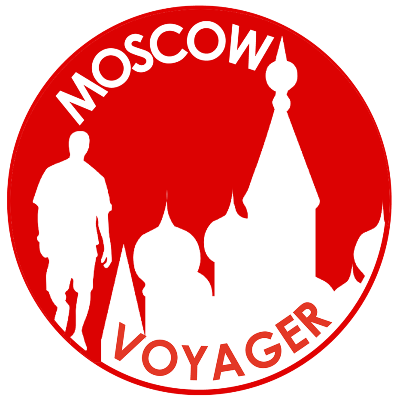
Gorky Park and Sparrow Hills: Green Lungs, place to relax and meet

Gorky Park and Sparrow Hills
The history of the gorky.
The park was built in Soviet times between the two world wars and named after the author Maxim Gorky at the time. Up until the turn of the century, the area not far from the center was only a residential area with huge estates and then, in the turmoil of the civil war and shortly afterwards, served as an illegal landfill where citizens and entrepreneurs disposed of their garbage. After intensive cleaning in the early communist years, the site was first used as an agricultural exhibition in the mid-1920s until the Moscow City Council decided to set up a park here that was accessible to all citizens of Moscow. After all, this was supposed to take a full ten years of construction. Throughout the entire Soviet period, the park was incredibly popular and familiar to every Soviet citizen, whether from Moscow or not.
Rebirth after basic renovation
However, after the end of the Soviet Union, the area fell into disrepair – cheap hustle and bustle like shooting booths and slowly rusting rides shaped the sad picture. Only outsiders got lost in the park, which lived more from its reputation than from the sad reality. Only with the fundamental and just as expensive renovation in 2011 did the Gorky become the park it was once loved by the locals. Especially the promenade along the river with its large sunbathing areas in summer and the numerous ice rinks for ice skating in winter now attract thousands of locals to Gorky every day. Countless food and café stands scattered across the site provide visitors with everything imaginable – from Georgian delicacies, a decent café to traditional Russian kvass, or ice cream and smoothies in summer.
Concerts, art and privacy place
Even bigger crowd pullers are just the concerts in the park and these have a long tradition here. In 2018 alone, David Guetta, the Red Hot Chili Peppers, the Killers and Lana del Rey performed numerous international music greats Open Air. But even outside the big events there is always something to see in the Gorky. The modern art center “Garage” (website https://garagemca.org/en ) in the park holds regular art and design exhibitions. In addition, the art center gave the park the largest children’s playground in all of Russia for its 90th birthday in 2018. Numerous play equipment, including 29 different swings alone, are the perfect place to spend a few hours with the youngsters. Pedal boats can also be rented at several locations in the park, for example at the Andreevsky ponds, which is also suitable for children. Sports courses for adults are held regularly in the park. From jogging to yoga or Pilates there are organized courses – beach volleyball fields, soccer fields and an open air fitness studio offer further opportunities to do sports. Afterwards, beer gardens invite you to linger – all of this happens primarily in the central part of Gorky Park, known as the Neskuchny Garden. Would you like to experience Gorky Park and the magic of Moscow by yourself? Then you need a visa first – you can find out how to get it here !

Away from the central part: Muzeon and Sparrow Hills
In the section called Muzeon north of the Crimean Bridge there are over 1000 statues, Soviet monuments and modern art facilities. This open-air museum-like section of the Gorky invites you to take a walk that takes you past oversized and pompous Soviet busts as well as avant-garde art objects of the 21st century. Surrounded by statues of Lenin, this section looks partly surreal. The Stalin statue in particular, which had its nose removed, magically attracts visitors. For photographers, the sometimes slightly rusty busts and remains from the Soviet era offer great motifs. If you’d like to improve yourself as a promising photographer, you can even take a photography course in the park at Photoplay ( https://photoplay.ru/courses/workshop/photoplayatgorky.html ) At 2900 rubles, i.e. just under $ 41, this is significantly more affordable than comparable products in Asia or Australia. No wonder this section is considered an Instagram paradise for Moscow’s exploding hipster scene. Events are also held time and again in the Muzeon – for example, the warm months over and over here are held cinema screenings outdoors. Russian classics such as international cinema are shown. You have absolute peace in the Sparrow Hills, which also belong to the park but are spatially separated from the other part. About four kilometers further along the Moskva River out of town is this section of the Gorky Park, which is largely natural. There, just opposite the large Luzhniki Stadium on the other side of the Moskva River, where the Olympics and the World Cup finals have already taken place, there is another privacy place in the middle of Moscow. At the highest point of the Sparrow Hills, to which a cable car leads, you have a fantastic view of Moscow.
Alexander Popov
Welcome to Russia! My name is Alexander, I was born in Moscow and I'm a passionate tour guide. I want to share my passion for Russia and my hometown with you. On my website you will find useful information to make your individual trip to Russia as interesting as possible.
Moscow’s Top 13 – The Main Attractions of the Russian capital
Moscow’s best free city tour, you will also like, traveling in russia – how safe it is..., choosing the best guide for a free and..., moscow subway: the most beautiful subway in the..., where to stay in moscow, the museum of cosmonautics and the planetarium in..., the lenin mausoleum – an absolute must visit..., shopping in moscow: gum, izmailovo, arbat, passage, the kremlin in moscow: how to buy tickets, bolshoi theater in moscow: history, tickets and tours, st. basil’s cathedral in moscow: visits and tickets, leave a comment cancel reply.
Save my name, email, and website in this browser for the next time I comment.
@2019-2020 - Moscow Voyager. Alexander Popov
We use cookies to provide you with a better experience. By continuing to use our site you accept our cookie policy. Accept Read More
- Skip to primary navigation
- Skip to main content
- Skip to primary sidebar
- Skip to footer
TravelAwaits
Our mission is to serve the 50+ traveler who's ready to cross a few items off their bucket list.
19 Unique And Fabulous Experiences In Moscow

- Destinations
Thinking of visiting Russia? When visiting such a famous city, one must, of course, visit the iconic landmarks first. Moscow has plenty of those, most of them in the center of the city, which is very well-planned for tourists. Once you’ve seen the sights that are on most travelers’ lists, it’s time to branch out and visit some of the lesser-known sites, and there are some fascinating places to see and things to do.
I know this list is long, but I just couldn’t help myself. You probably won’t have the time to see them all. But that’s okay. Just scroll through the list and choose what sounds the most interesting to you. Where possible, make sure to book in advance, as things can get crowded, especially during high season.

1. The Red Square, Kremlin, And Surroundings
Red Square (Krasnya Ploshad) is the heart and soul of Russia, and where much of the country’s history has unfolded. This is the most famous landmark in Moscow and indeed the whole country, it’s an absolute must-do! The square is always full of people and has a rather festive atmosphere!
Saint Basil’s Cathedral
This is the famous church with the rainbow-colored, onion-domed roof. The cathedral was commissioned in the 1500s by Ivan the Terrible and according to legend, the Tsar thought it was so beautiful, that he ordered that the architect’s eyes be cut out afterward, so he could never build anything more beautiful! He wasn’t called Ivan the Terrible for no reason!
Lenin’s Mausoleum
The “love-it-or-hate-it” of tourist attractions in Russia. A glass sarcophagus containing the embalmed body of Russian revolutionary, Vladimir Lenin. It may seem a bit bizarre to display the mummy of a person, but it has been there for almost half a century and the 2.5 million visitors who come each year, clearly feel the queuing and thorough body search are worth it, to be in Lenin’s presence.
Pro Tip: no photos and no loud talking are allowed inside the Mausoleum.
Eternal Flame
There is an Eternal Flame in honor of an unknown soldier on the left side of Red Square. The hourly changing of the guards is worth seeing.
The Kremlin is the official residence of the Russian president. You can see it from the outside, or you can take an excursion to one of the museums located inside. This is the biggest active fortress in Europe, and holds a week’s worth of attractions! Once behind the 7,332-feet of walls, there are five squares, four cathedrals, 20 towers, various museums, and the world’s largest bell and cannon to see. Worth a special mention is the Armory Chamber that houses a collection of the famous Faberge Eggs.
Pro Tip: You can only go inside the Kremlin if you are part of a tourist group.

2. Bolshoi Theatre
Bolshoi Theatre translates to “The Big Theatre” in Russian, and the building is home to both the Bolshoi Ballet and Bolshoi Opera — among the oldest and most famous ballet and opera companies in the world.
Pro Tip: It’s hard to get an inexpensive ticket, so if you’re reading well in advance of going to Moscow then try buying tickets on the official website . Last-minute tickets cost around $250 per person. If this is out of your budget, about an hour before a performance, you can try buying a ticket at the entrance from a reseller. Most can speak enough English to negotiate the price.
Tour the Bolshoi Theatre: You can take a group guided tour of the Bolshoi Theatre which focuses on the history and architecture of the theatre and behind the scenes. There’s an English language tour that lasts 2 hours and costs around $300 for a group of up to six.

3. Luxury Shopping At GUM And TSUM
Russia’s main department store, GUM, has a stunning interior that is home to over 100 high-end boutiques, selling a variety of brands: from luxurious Dior to the more affordable Zara. Even if shopping is not on your Moscow to-do list GUM is still worth a visit; the glass-roofed arcade faces Red Square and offers a variety of classy eateries. TSUM, one of the biggest luxury malls in town, is right behind the Bolshoi and GUM. It’s an imposing building with lots of history, and worth a visit just for its design and its glass roof.

4. Christ The Savior Cathedral
This is one of Russia’s most visited cathedrals and is a newer addition to the gorgeous array of Muscovite cathedrals, but don’t let its young age fool you. After perestroika, in the early 90s, the revived Russian Orthodox Church was given permission to build a cathedral on this site. It did the location honors and built the largest temple of the Christian Orthodox Church. The façade is as grand as you’d expect, but it’s the inside that will mesmerize you, with its domes, gold, gorgeous paintings, and decor!
The cathedral is located just a few hundred feet away from the Kremlin and was the site of the infamous Pussy Riot protest against Putin back in 2012.
Pro Tip: Bring a shawl to cover your hair as is the local custom.

5. Gorky Park
Moscow’s premier green space, Gorky Park (Park Gor’kogo) is the city’s biggest and most famous park. There is entertainment on offer here for every taste, from outdoor dancing sessions to yoga classes, volleyball, ping-pong, rollerblading, and bike and boat rental in summer. In winter, half the park turns into a huge ice skating rink. Gorky Park is also home to an open-air movie theater and the Garage Museum of Contemporary Art. There is also Muzeon Art Park, a dynamic contemporary space with a unique collection of 700 sculptures. It is located right in front of Gorky Park.
6. Sparrow Hills Park
If you take a walk from Gorky Park, along the Moscow River embankment, you’ll end up in the city’s other legendary park, Sparrow Hills. Although the park doesn’t offer as many activities as its hip neighbor, it has a great panoramic view of the city
Pro Tip: You can take a free walking tour to all of the above attractions with an English-speaking guide.

7. River Cruising
One of the best ways to experience Moscow, and see all the famous landmarks, but from a different angle, is from the Moscow River. Take a river cruise. Avoid the tourist crowds. There are little nameless old boats that do the cruise, but if you are looking for a more luxurious experience take the Radisson Blu cruise and enjoy the sights with some good food and a glass of wine.

8. Metro Hopping
Inaugurated in the 1930s, the Moscow Metro system is one of the oldest and most beautiful in the world. Started in Stalinist times, each station is a work of art in its own right. I’d recommend touring the stations between 11 a.m. and 4 p.m. This way, you’ll be able to properly see it without the crowds. Ideally, I’d recommend taking a tour with a knowledgeable guide with GuruWalk, who will tell you stories of forgotten stations and how the history of the country is interconnected with the metro development. If going by yourself, then I definitely recommend checking out: Mayakovskaya, Ploschad Revolutsii, Kievskaya, Kropotkinskaya, Kurskaya, and Novoslobodskaya stations.
Visit the free Moscow Metro Museum: For real train enthusiasts, located in the southern vestibule of Sportivnaya station is a small free museum. Here you can take a peek into the driver’s cabin, see a collection of metro tokens from different cities, and see different models of a turnstile, traffic lights, escalator, and more.

9. Moscow State University View
In his effort to create a grander Moscow, Stalin had seven skyscrapers built in different parts of town; they’re called the Seven Sisters. The largest of these buildings and the one with the best view is the main building of the Moscow State University. Although this is a little outside the city center, the view is more than worth it.

10. Izmailovsky Market
Mostly known for the city’s largest flea market, the district of Izmaylovo is home to a maze of shops where you can get just about anything, from artisan crafts to traditional fur hats, handcrafted jewelry, fascinating Soviet memorabilia, and antiquities. It’s also one of Moscow’s largest green spaces. There are often no price tags, so be prepared to haggle a bit. Head to one of the market cafes for a warming mulled wine before continuing your shopping spree.
The History of Vodka Museum is found here, and the museum’s restaurant is the perfect place to sample various brands of the national drink.
Once you’ve covered the more touristy spots, Moscow still has plenty to offer, and the places below will also be full of locals! So for some local vibes, I would strongly recommend the spots below!

11. Moscow City
With a completely different vibe, Moscow City (also referred to as Moscow International Business Center) is like a mini Dubai, with lots of impressive tall glass buildings. Here is where you’ll find the best rooftops in towns, like Ruski Restaurant, the highest restaurant both in Moscow City and in Europe. Moscow City is great for crowd-free shopping and the best panoramic views of the city.

12. Tretyakov Gallery
Tretyakov Gallery started as the private collection of the Tretyakov brothers, who were 19th-century philanthropists. They gave their private collection to the government after their deaths. If there is just one museum you visit in Moscow, I recommend this one!

13. Tsaritsyno Museum-Reserve
Tsaritsyno was a residence of Catherine the Great more than two centuries ago. It became derelict during the Soviet era but has now been fully renovated. With its opulently decorated buildings, gardens, meadows, and forests, Tsaritsyno Park is the perfect place for a green respite in Moscow.

14. Kolomenskoye
A 10-minute metro ride from the city center is Kolomenskoe Museum-Reserve, where you can get an idea of what Russia looked like 200 years ago. You’ll find ancient churches (one dating back to the 16th century), the oldest garden in Moscow, and the wonderful fairytale wooden palace of Tsar Alexey Mikhailovich, father of Peter the Great.

15. Ostankino TV Tower
Built in 1967, Ostankino TV Tower was the tallest free-standing construction in the world at the time, it’s still the 8th tallest building in the world and the highest in Europe. It’s also the best observation deck, with a glass floor and 360-degree views. The speedy elevators take you 1,105 feet in next to no time.
Pro Tip: You need to book in advance; entrance is based on specific ticket times and the capacity is limited and only a certain number of tourists are allowed per day. Don’t forget your passport, you’ll need it to get through security.

16. Zaryadye Park
Zaryadye is a newly opened, landscaped urban park so new you won’t find it in a lot of tour guides. The park is near Red Square and is divided into four climatic zones: forest, steppe, tundra, and floodplains, depicting the variety of climatic zones in Russia.
These last three suggestions are a little quirky, but all are really worth checking out.
17. Museum Of Soviet Arcade Games
Release your inner child playing on 66 arcade machines from the Soviet era! What a great way to spend a couple of hours when tired of visiting museums and palaces. The staff speaks excellent English and are happy to explain how the games work.

18. Moscow Rooftop Tour
Take a 1-hour private Moscow rooftop tour with an experienced roofer. I can just about guarantee none of your friends will be able to say they’ve done it! For your comfort, I recommend wearing comfortable shoes. Take your camera, there are some amazing photo opportunities out there!

19. Sanduny Banya
This classical Russian bathhouse opened its doors in 1808 and is famous for combining traditional Russian banya services with luxurious interiors and service. If you enjoy spas and saunas, then you should experience a Russian bathhouse at least once in your life! Go with an open mind and hire a specialist to steam you as it’s meant to be done — by being beaten repeatedly with a besom (a leafy branch)! This is said to improve circulation, but is best done by a professional!
So there you have my list of things to do in Moscow. I could have gone on and on and on, but I didn’t want to try your patience! There are so many things to do in this vibrant city that you’ll definitely need to allocate several days for exploring.
Here are some other reasons to visit Moscow and Russia:
- 7 Reasons To Put Moscow On Your Travel Bucket List
- Russia 30 Years (And 30 Pounds) Ago
- Massive Mysterious Craters Appearing Again In Siberia

Born and raised in Sydney, Australia, before moving to Africa at the age of 21, Sarah Kingdom is a mountain climber and guide, traveler, yoga teacher, trail runner, and mother of two. When she is not climbing or traveling she lives on a cattle ranch in central Zambia. She guides and runs trips regularly in India, Nepal, Tibet, Russia, and Ethiopia, taking climbers up Tanzania’s Mount Kilimanjaro numerous times a year.
INTERACTIVE
The ten most-visited u.s. urban parks.
Many of these urban oases date from the mid- to late-19th Century, when a public parks movement led to the creation of large urban reserves, often modeled on English gardens. Explore the ten most visited U.S. urban parks with this interactive map from Esri.
Geography, Human Geography, Social Studies, Civics, U.S. History

Media Credits
The audio, illustrations, photos, and videos are credited beneath the media asset, except for promotional images, which generally link to another page that contains the media credit. The Rights Holder for media is the person or group credited.
Partner Organization
Last updated.
October 19, 2023
User Permissions
For information on user permissions, please read our Terms of Service. If you have questions about how to cite anything on our website in your project or classroom presentation, please contact your teacher. They will best know the preferred format. When you reach out to them, you will need the page title, URL, and the date you accessed the resource.
If a media asset is downloadable, a download button appears in the corner of the media viewer. If no button appears, you cannot download or save the media.
Text on this page is printable and can be used according to our Terms of Service .
Interactives
Any interactives on this page can only be played while you are visiting our website. You cannot download interactives.

Related Resources
- Bahasa Indonesia
- Slovenščina
- Science & Tech
- Russian Kitchen
5 of Moscow's most BEAUTIFUL districts
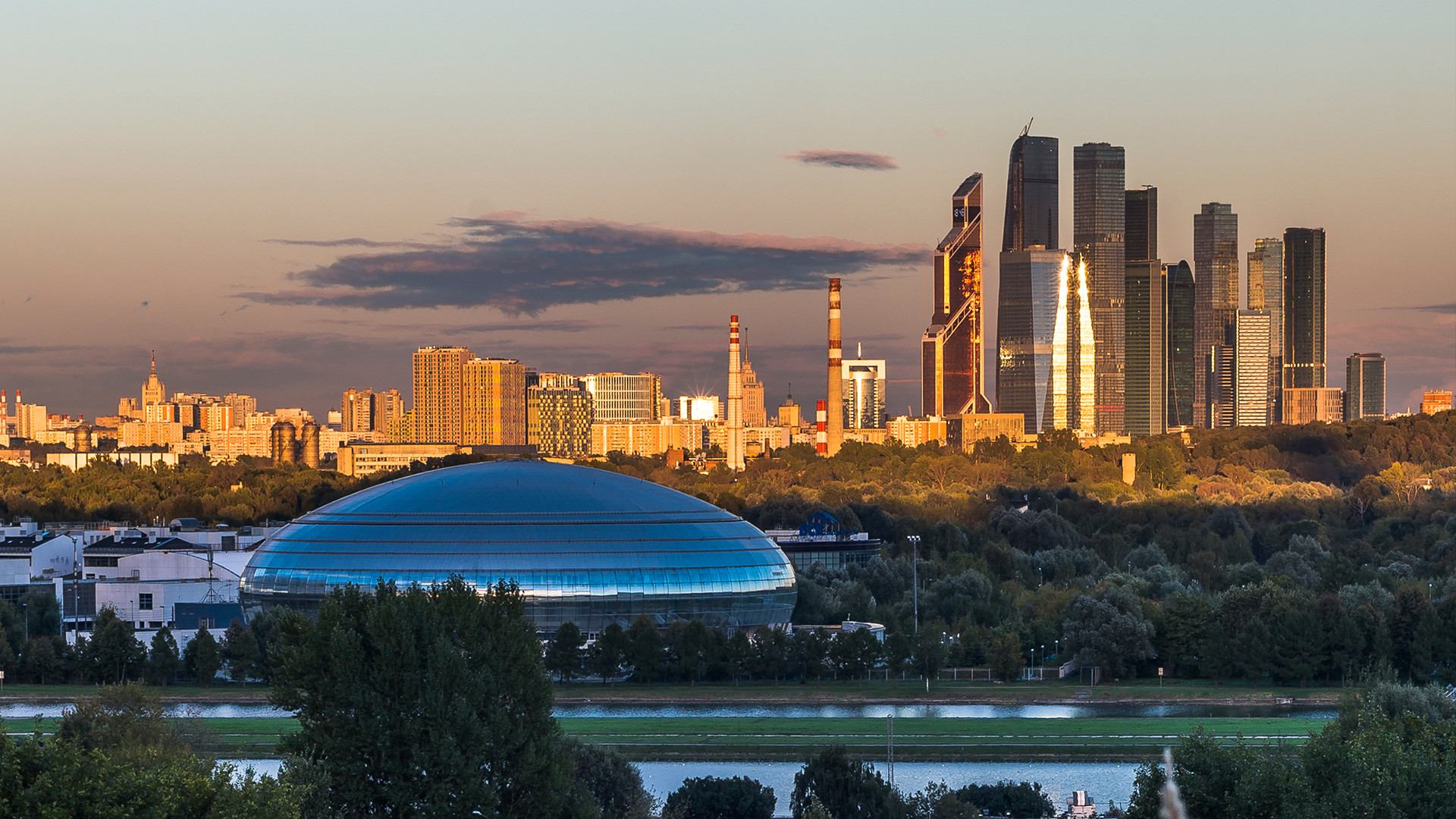
1. Sokolniki
By 9 a.m., the main square of Sokolniki district in the northeast of Moscow begins to fill up with dog-walkers and cyclists. The mobile coffee shops and hot dog outlets are not open yet; the only sounds are the rustling of the autumn leaves and gurgling of the main fountain, around which sleepy guards walk.
“But on the weekend, there are crowds of people here, as if the whole of Moscow descends on it,” says Raisa Bazarova, a resident of Sokolniki. She says that she literally “married” Sokolniki 21 years ago, in 1999, when she moved from the central Arbat district to live with her new husband.
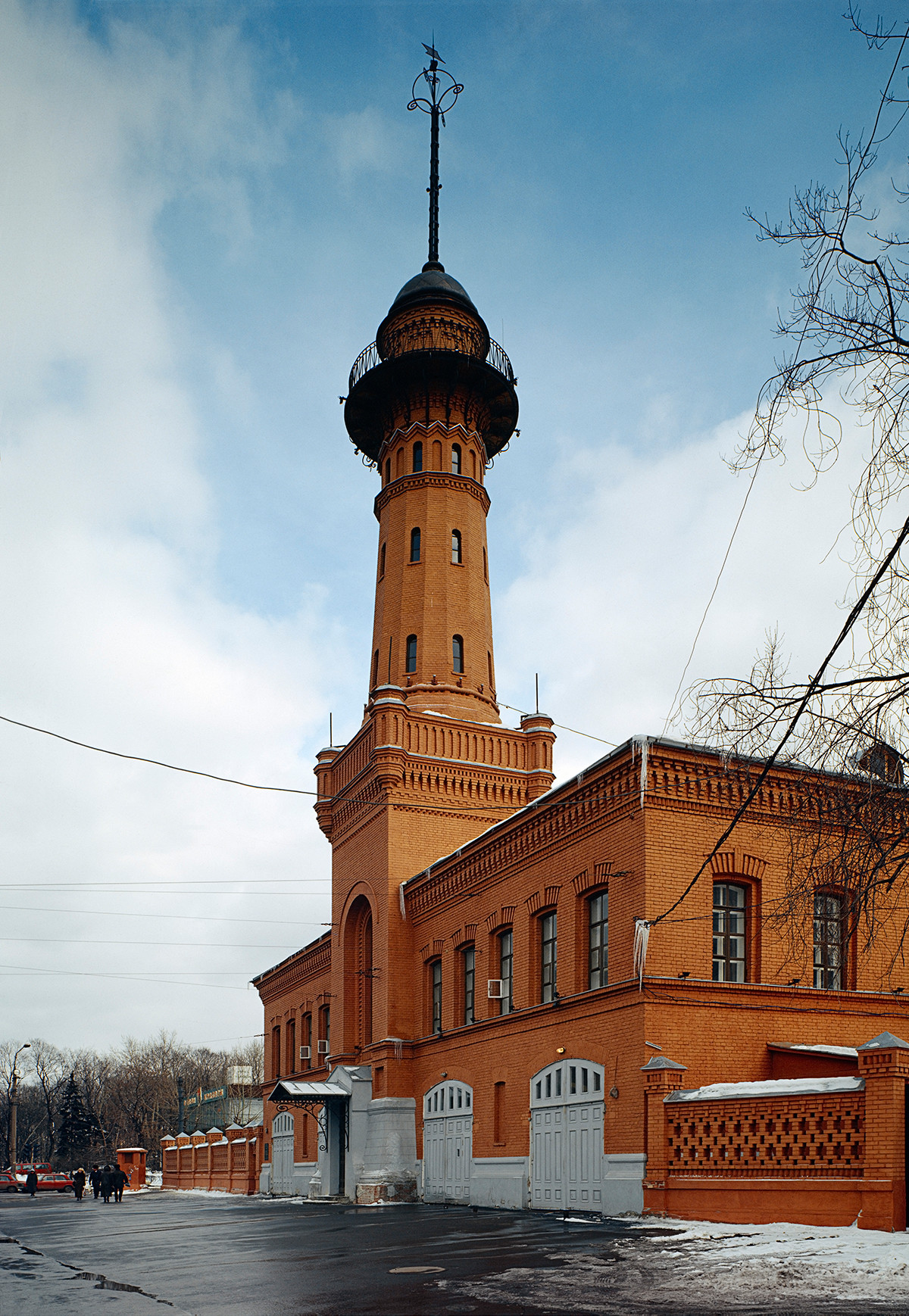
Police fire station with a tower-tower in Sokolniki
It took three years for her to feel at home, finally making friends with the neighbors. Now, Raisa considers it the most beautiful area of Moscow and is fond of its low-rise skyline and architectural monuments.
“As soon as you step out of the subway, you’re in Sokolniki, and the first thing that catches the eye is the pre-revolutionary watchtower [built in 1884]. It saw the old wooden Moscow and has been preserved in all its splendor,” says Bazarova.
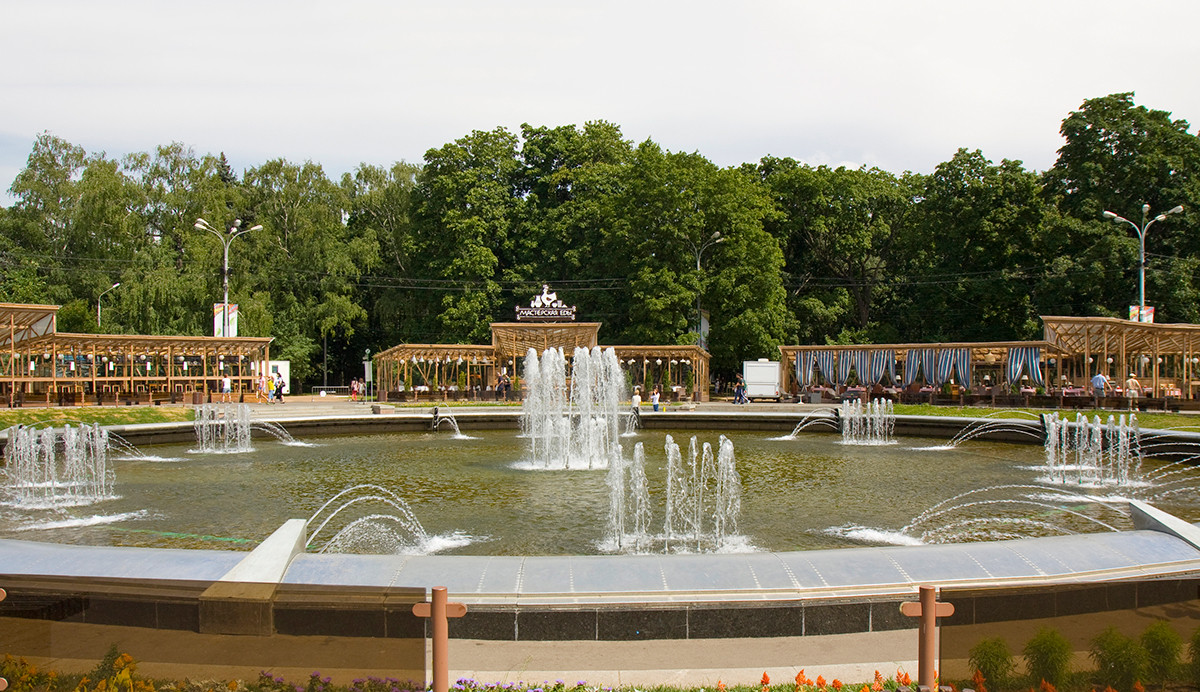
Moscow, park Sokolniki
Raisa also advises foreigners to visit Sokolniki Park, one of the oldest in Moscow, founded in 1878, with fountains, ponds, a swimming pool, an amusement park and its own rose garden. Sokolniki was adored by Peter the Great and Alexander I and it was here that they often held feasts. For Bazarova, the lush greenery makes it the “lungs” of the district.
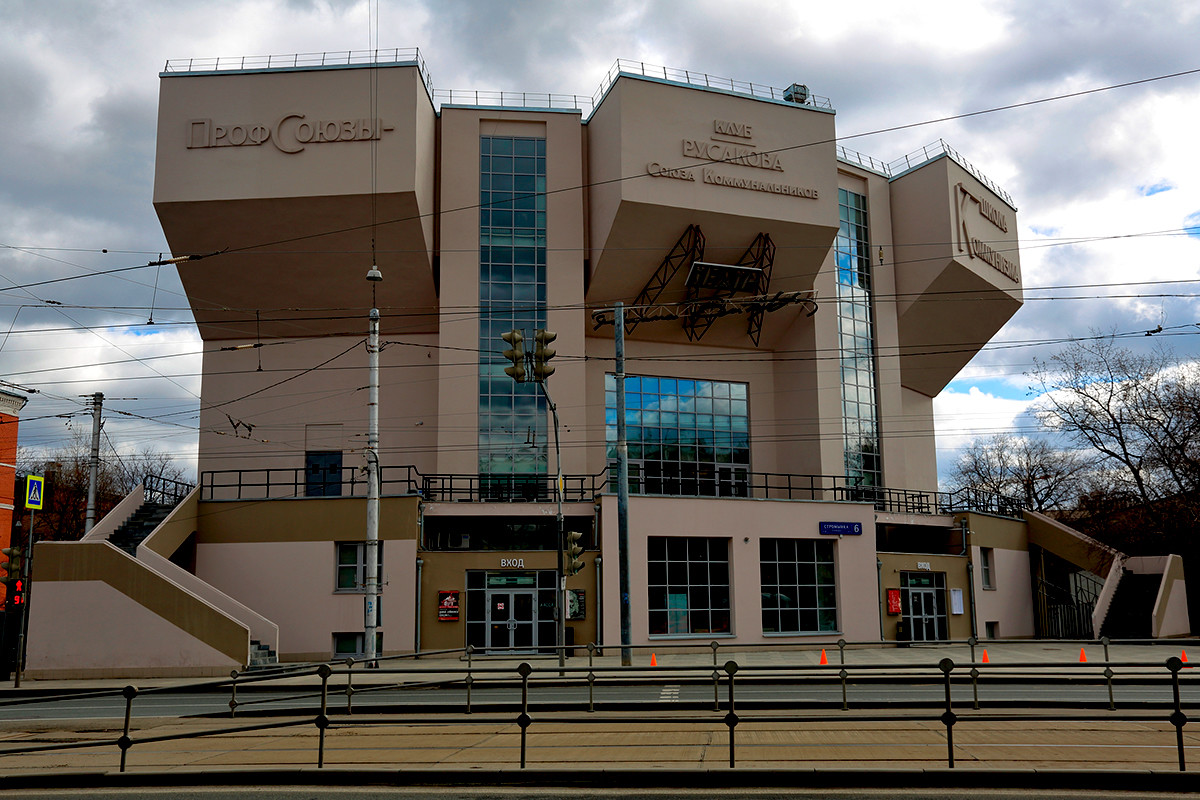
The Viktyuk Theater. The building of the outstanding architect Konstantin Melnikov, 1929
Another must-see, according to Bazarova, is the Roman Viktyuk Theater — if nothing else, then to see one of Moscow’s main architectural gems, designed and built in the Constructivist style that prevailed in the city in the 1920s. Moreover, Russian-speaking theater lovers might want to catch a performance of ‘The Maids’ by French playwright Jean Genet.
2. Levoberezhny
Galina Yakunina, director of a sports club in Moscow’s north for nine years, walks with unfeigned pleasure along the main alley of Rechnoy Vokzal (“River Station”) Park, which was restored in 2020 under the ‘My district’ city improvement program.
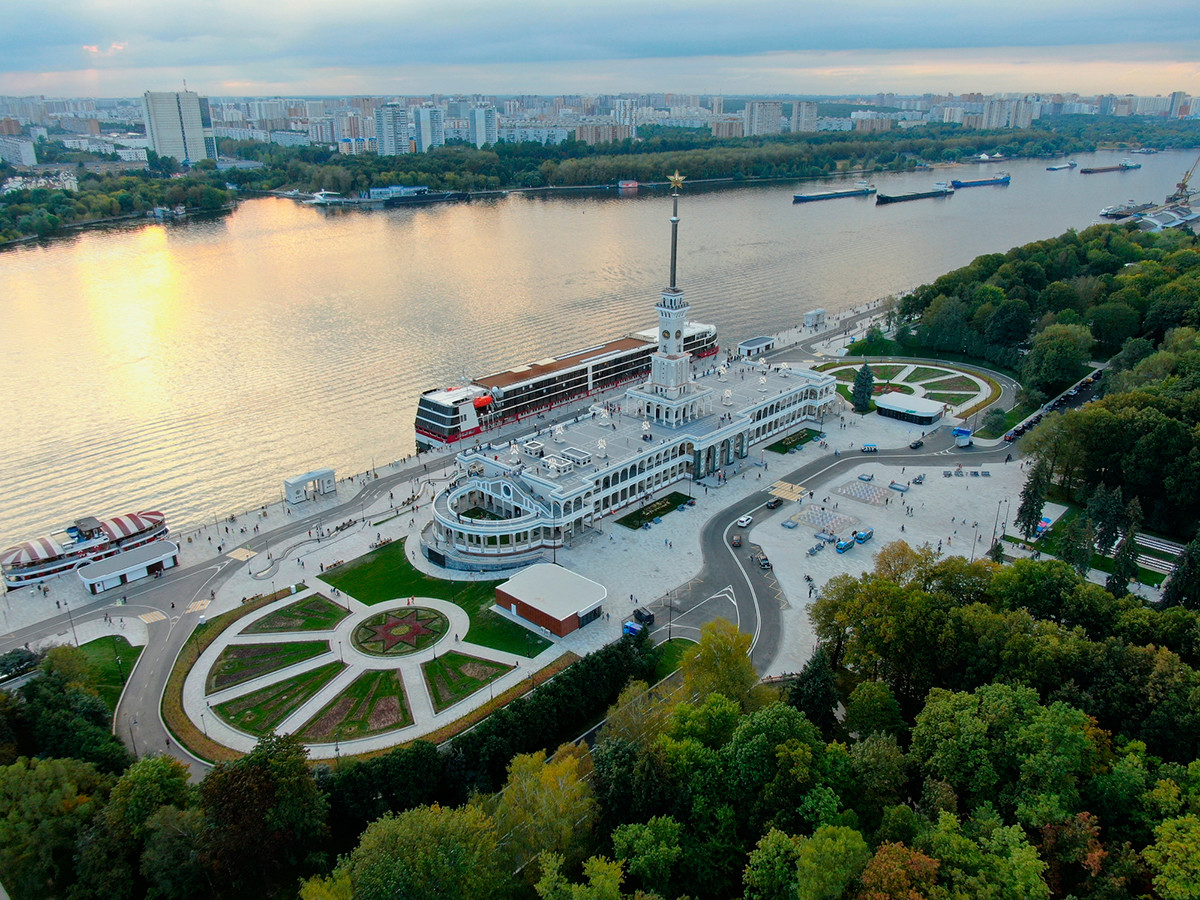
Aerial view is a beautiful panorama of the renovated Northern River Station in Moscow
In the summer of 2020, the station, which resembles a ship, was enveloped in scaffolding, as the original 1937 edifice was being restored. Today, it is surrounded by fountains with children running around, endless flower beds and an all-new embankment that runs along a miniature replica of the Moscow Canal, replete with children’s paddle boats and other attractions.
“It’s really beautiful. Cruise ships and motor vessels depart from here. Muscovites love it and tourists definitely will as well,” says Yakunina.
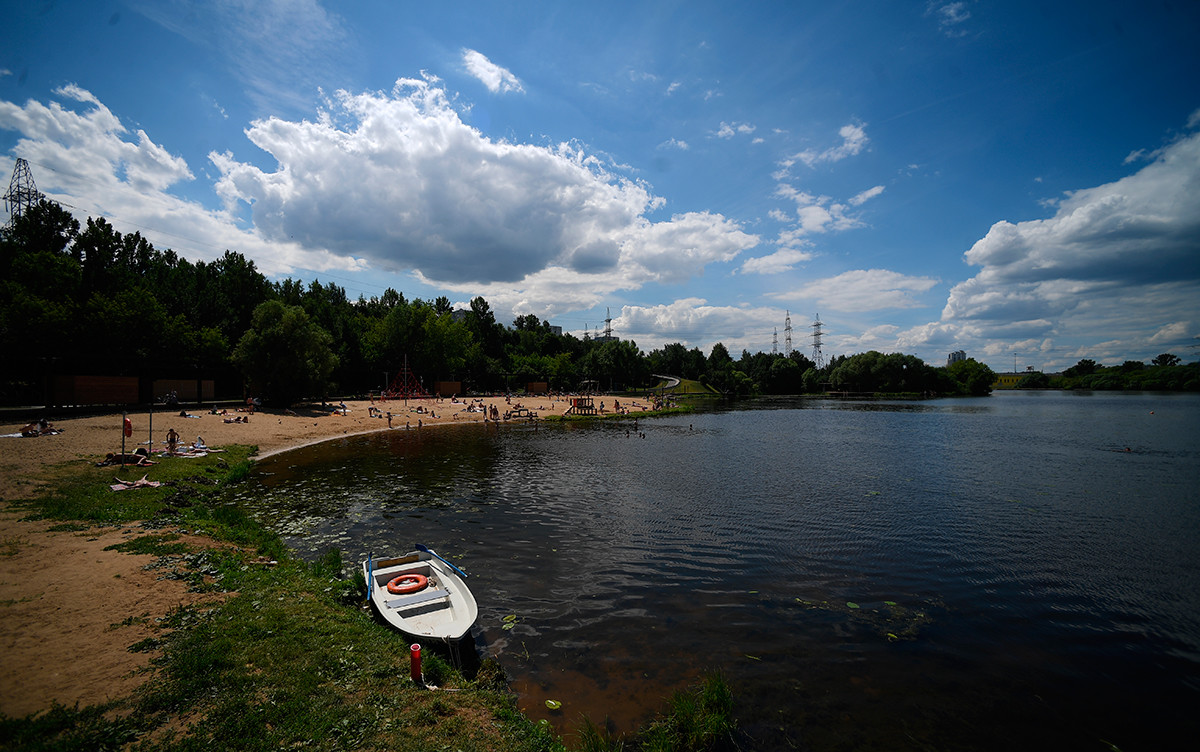
Park Levoberezhnyj, Moscow
Her second favorite place for a post-work evening stroll is Druzhba (Friendship) Park, laid out for the 6th World Festival of Youth and Students in 1957. The main features are its monuments and sculptures dedicated to children, international friendship and war heroes, as well as the pond-reflected willows and the playgrounds. Thanks to these two parks, the air in the district differs sharply from that in central Moscow - that she is sure of.
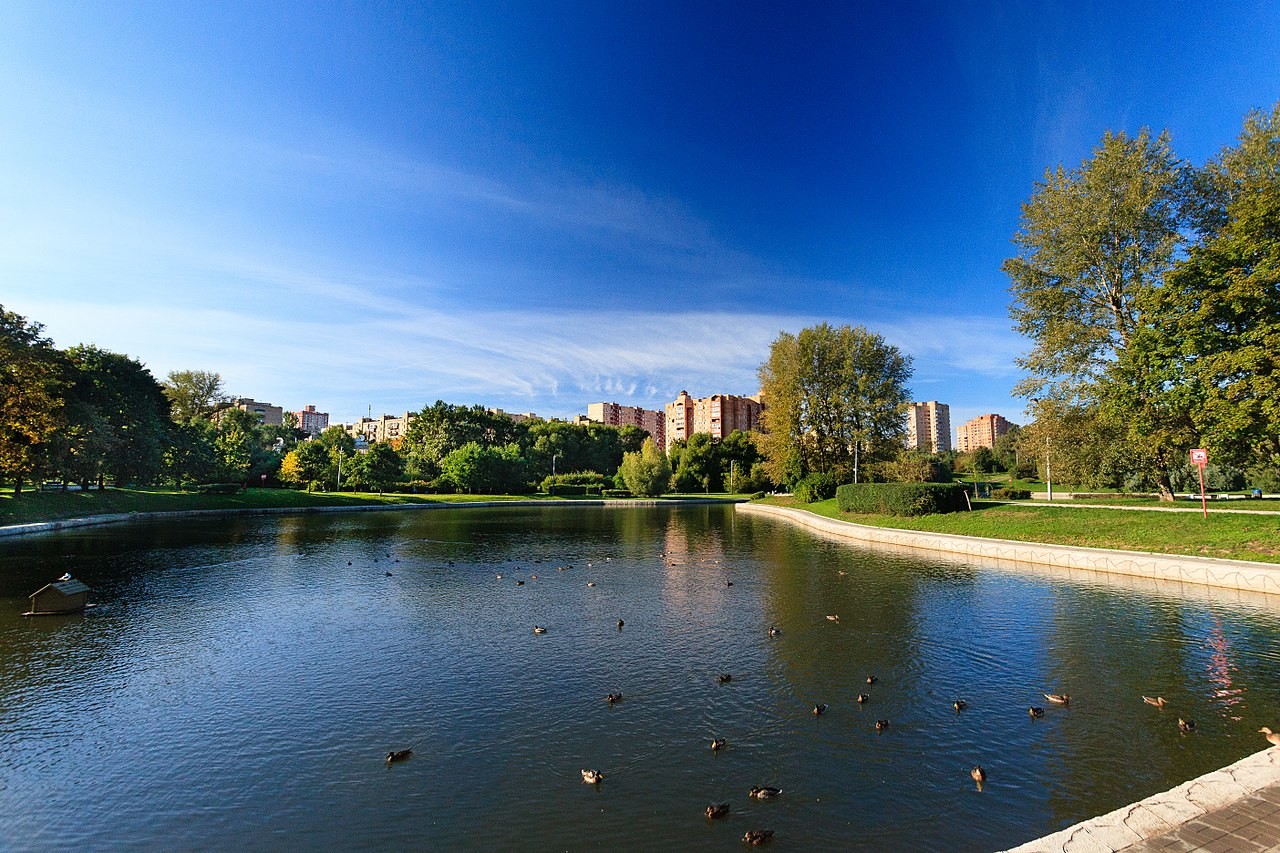
Park Druzhby
In summer, Levoberezhny beach (renovated under the ‘My district’ city improvement program in 2018) becomes the main focal point and Galina heartily recommends it to tourists.
“The beach is covered with sand, with a cafe, sun loungers and beach volleyball. It’s very relaxing,” she says, describing the place.
3. Filevsky Park
For social conflict expert Alexei Ivanushkin, Filevsky Park in the city’s west has always been the main symbol of Moscow.
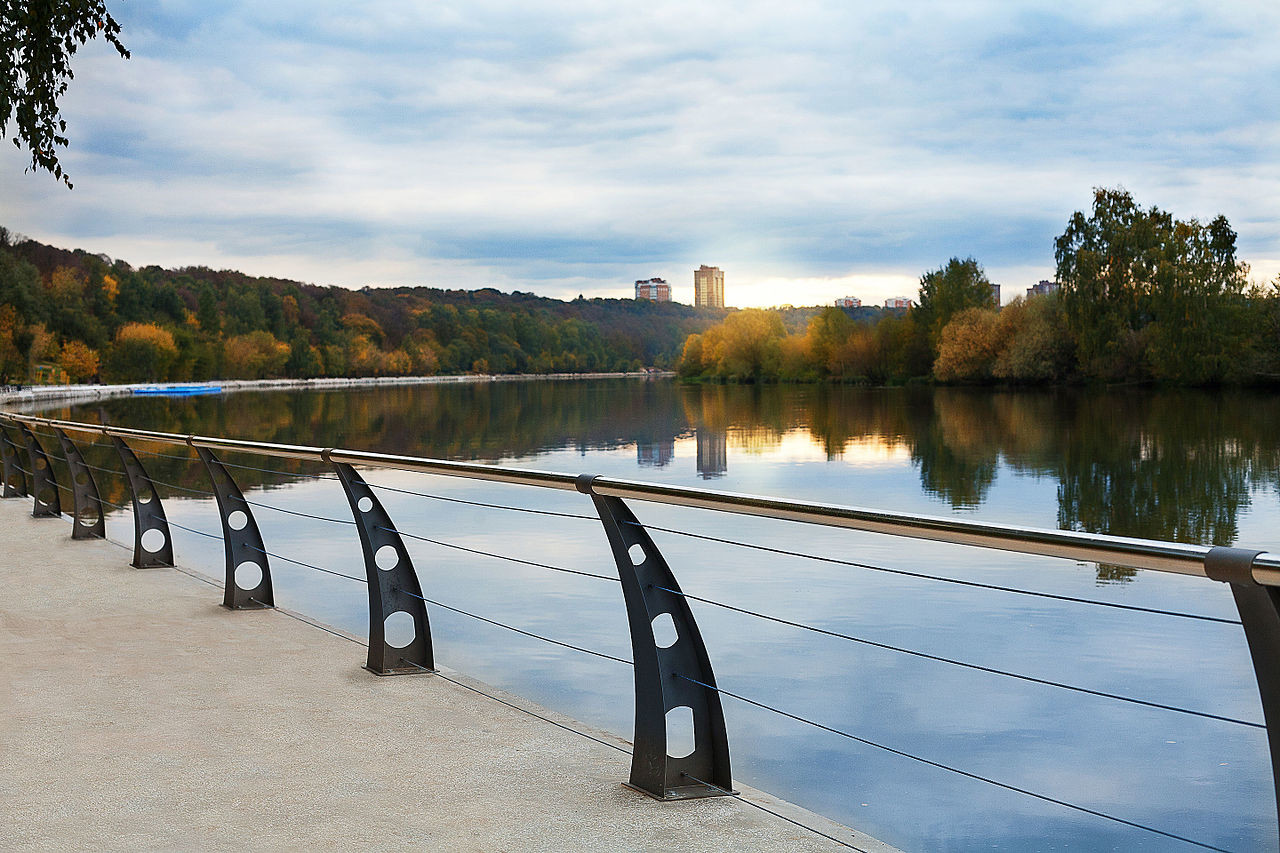
Fili Park embankment
“I moved here in 2005 from St Petersburg, when the Gorbushka electronics market was one of Moscow’s main draws. There were always crowds of people, poorly dressed, but eager for gadgets. We used to go to the wooded parts of Filevsky Park, clearing branches, because it was impossible to get through. There were bottles everywhere that people had just left. In other words, it was a hub for alcoholics,” Ivanushkin shares his first impressions of the area.
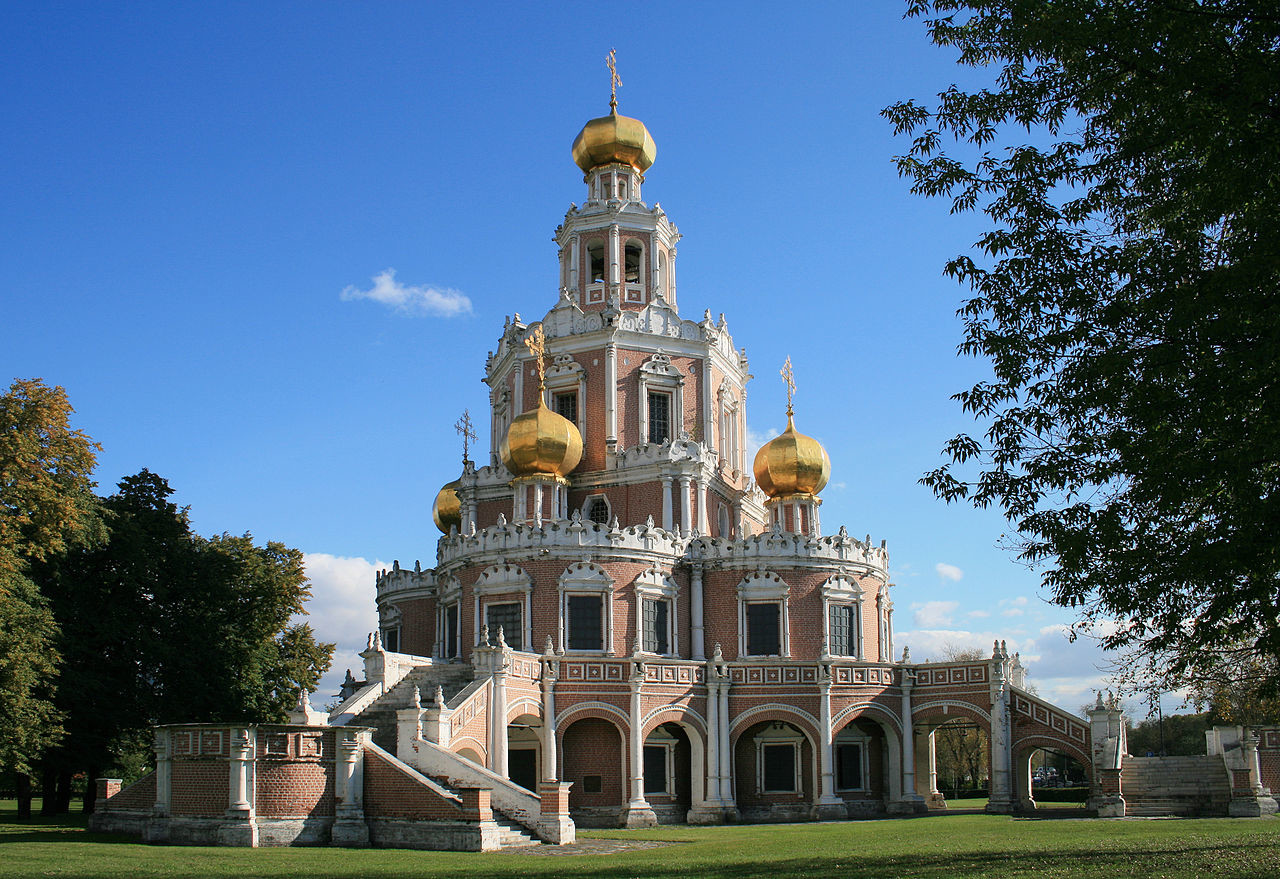
Church of the Protection of the Theotokos in Fili, 1690-1694, Moscow
Fifteen years later, the now-landscaped embankment of the park is Alexei’s favorite spot for daily walks and he also advises tourists to visit.
“For me, the place is full of energy and inspires the soul,” says Ivanushkin.
No less significant is the Baroque Church of the Intercession at Fili, constructed in the late 17th century and financed by the boyar Lev Naryshkin, asserts Ivanushkin. In 1812, Napoleon’s soldiers converted the first floor of the church into a stable. In 1943, the lower church was used as a hospital and then, until 1963, as a warehouse for paper products. Highly recommended to anyone interested in unusual places of worship.
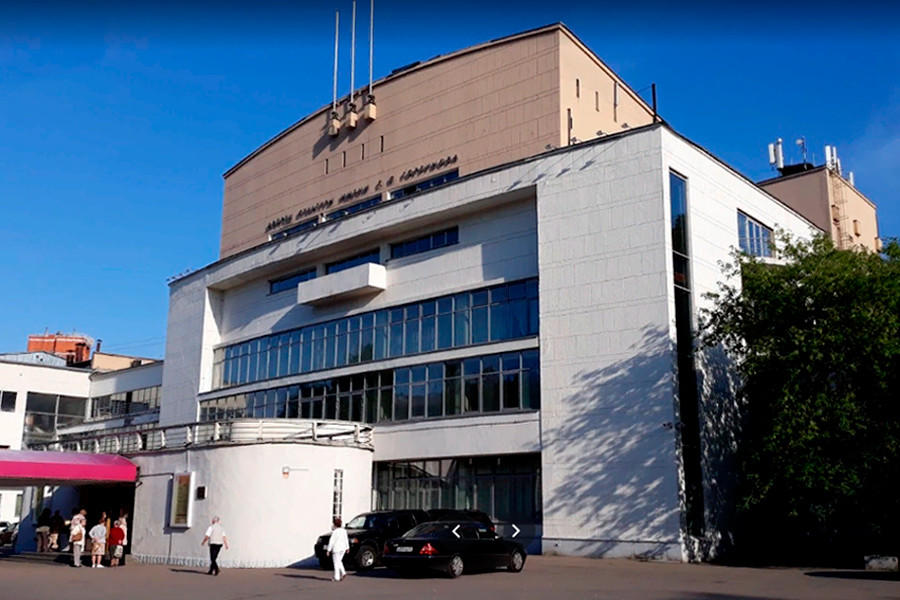
Gorbunova recreation center
“The Suvorov Military School stood opposite the church. And every year at the graduation ceremony, it was a tradition for graduates to secretly raise the flag of the armed forces on the building. They tried to stop it, but no one was ever punished,” recounts Ivanushkin.
To learn more about Russian rock music, Alexei advises a visit to the Gorbunov Palace of Culture, named after Sergei Gorbunov, the director of an aircraft factory and built in 1938. In 1986, it housed the first “rock-n-roll laboratory” in Moscow, earning the building a reputation as the capital’s premier venue for rock concerts and festivals.
4. Krylatskoe
To learn more about sports facilities built for the 1980 Moscow Olympics, Krylatskoye is the place to start, says local resident Yulia Zhiltsova, who moved to Moscow from Siberia and has lived in the city’s western part for 21 years.
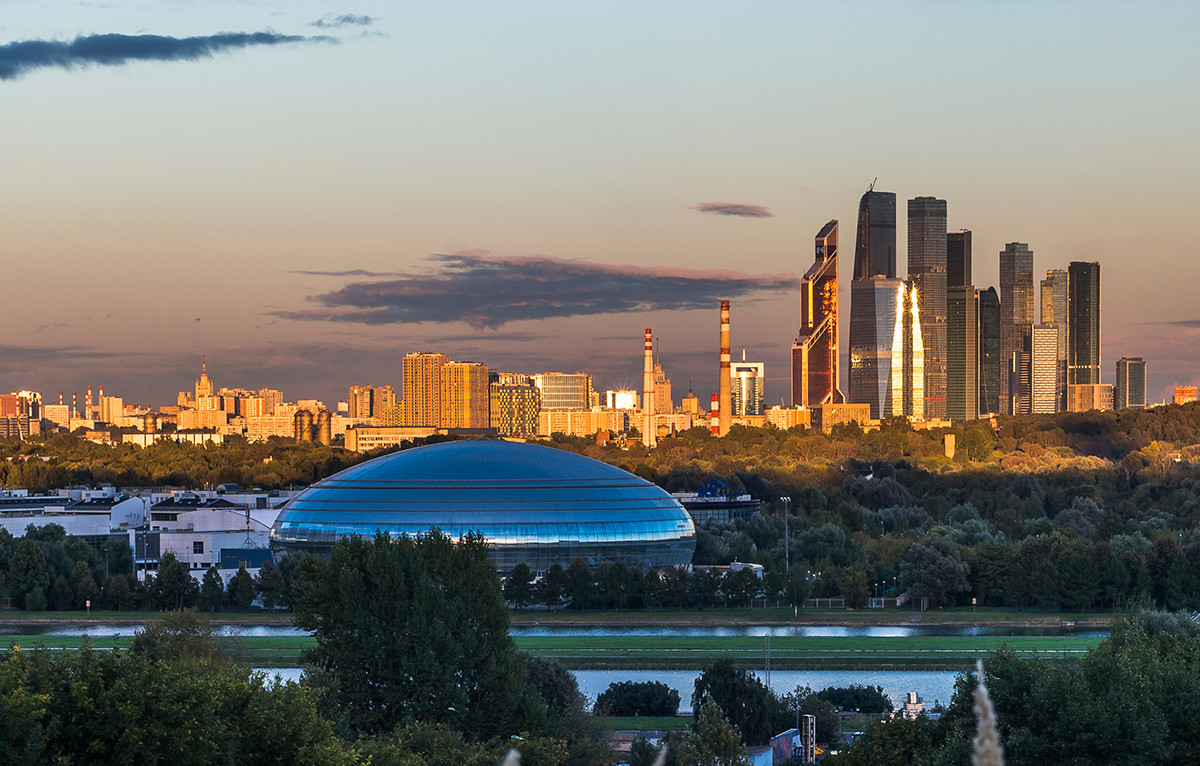
Krylatsky hills. Panorama
“I love walking around the velodrome and other Olympics facilities. There’s also a speed-skating center and rowing canal. Red Bull regularly organizes the Flugtag competition here, it’s really fun and interesting,” notes Zhiltsova.
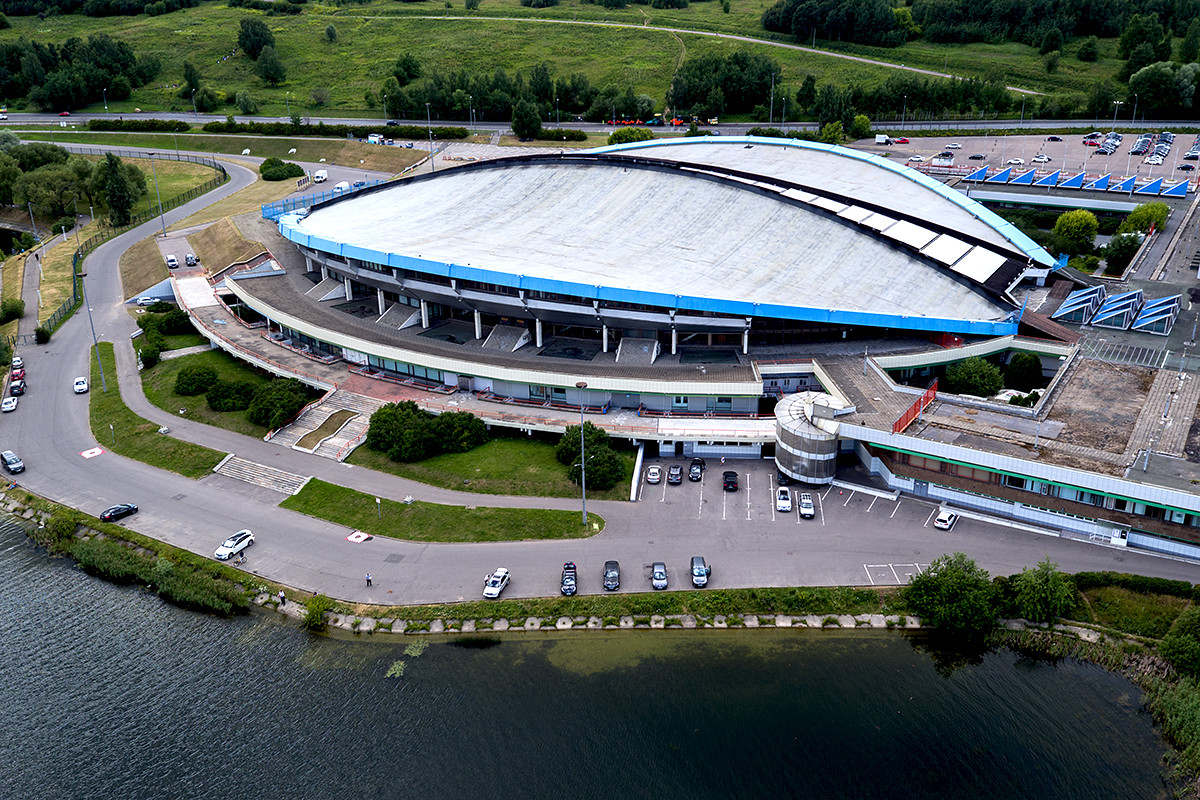
Cycle Track "Krylatskoe"
In her free time, Yulia enjoys what are perhaps the capital’s most beautiful views from West Krylatsky Hill in the nearby park, offering a panorama of Moscow-City, the Church of the Nativity of the Most Holy Theotokos and the arch of Zhivopisny Bridge.
She advises tourists to climb the hill, take shots of the stunning Moscow backdrops and escape the hustle and bustle of the central historical districts.
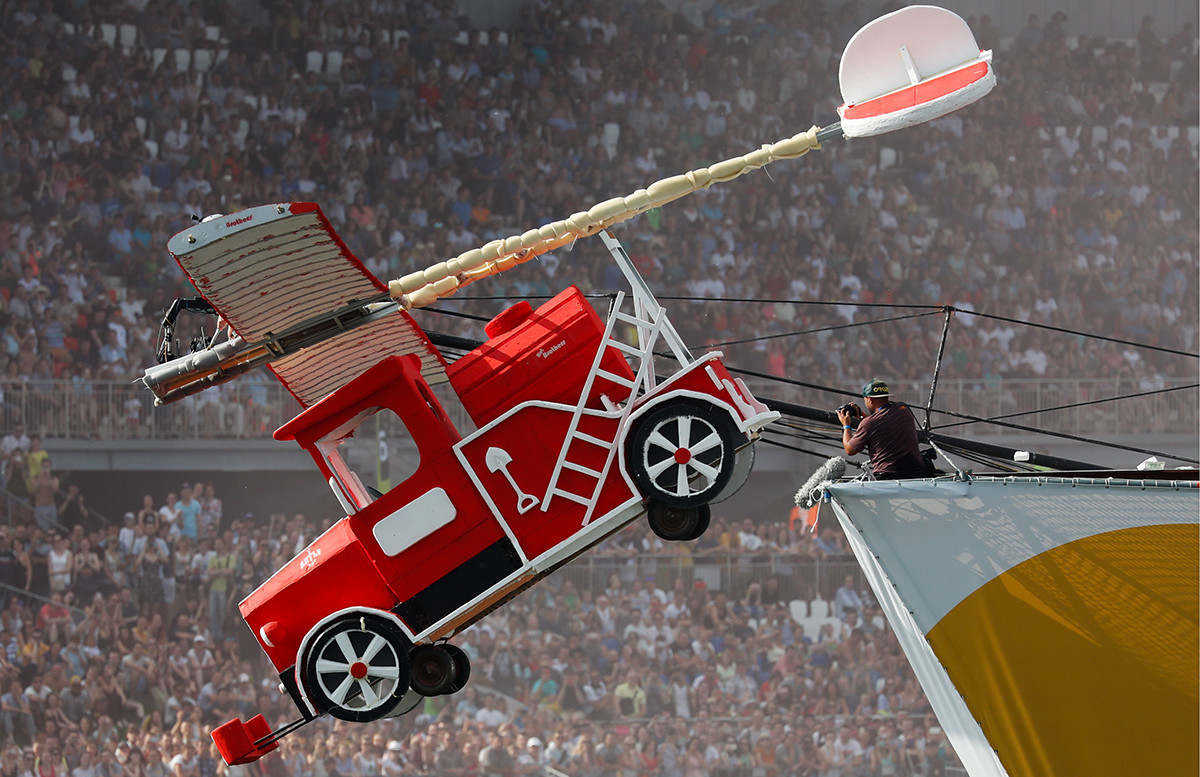
Red Bull Flugtag 2017 in Moscow
“Here you feel at one with nature, yet central Moscow is just 20 minutes down the road. There are no crowds, even on weekends. The center is packed and impersonal, but here the atmosphere is a bit more homely,” Zhiltsova explains.
5. Khoroshevsky
Khodynskoe Field in the Khoroshevsky district is notorious as the site of a deadly crush during celebrations to mark the coronation of Nicholas II in 1905. Today, it looks more like a futuristic city with fantastical towers, art objects in the local park and dancing fountains. By 8 p.m. on weekdays, the park is especially crowded — school students shoot TikTok dance videos and ride skateboards, while children run with their parents through the mirror maze.
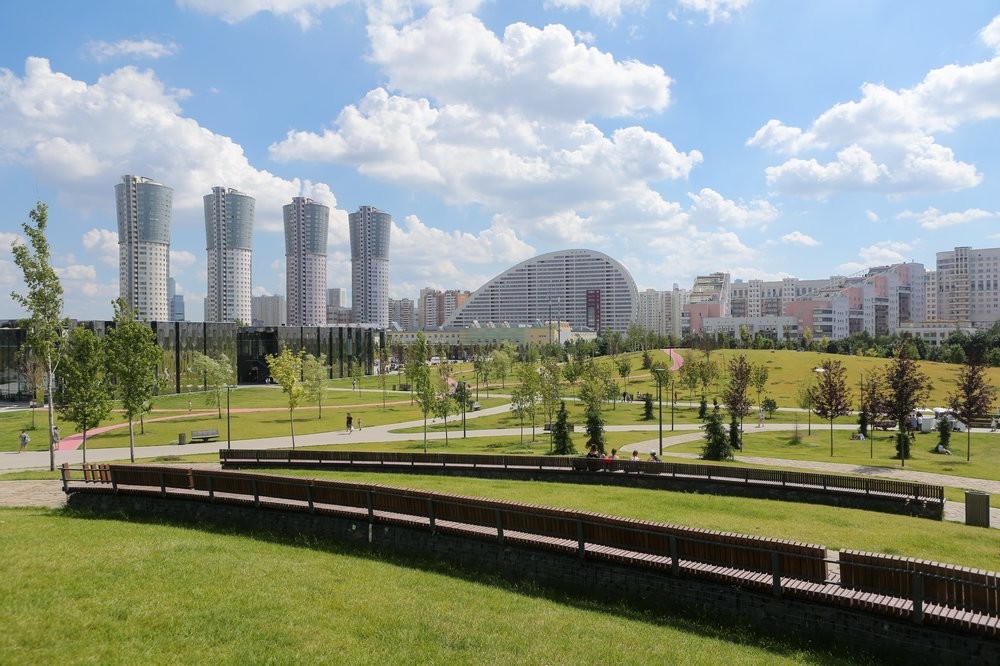
Local resident Alexander Lyubarsky moved to Khodynka in 2010 and, as a photographer, immediately fell in love with the views.
“Every part of Khodynsky Park — be it a swing, a pond, a sports ground stylized as an airplane and helicopter, or the fountains behind us — is photogenic,” explains Lyubarsky. The Park appeared in 2018 under the ‘My district’ city renovation program.
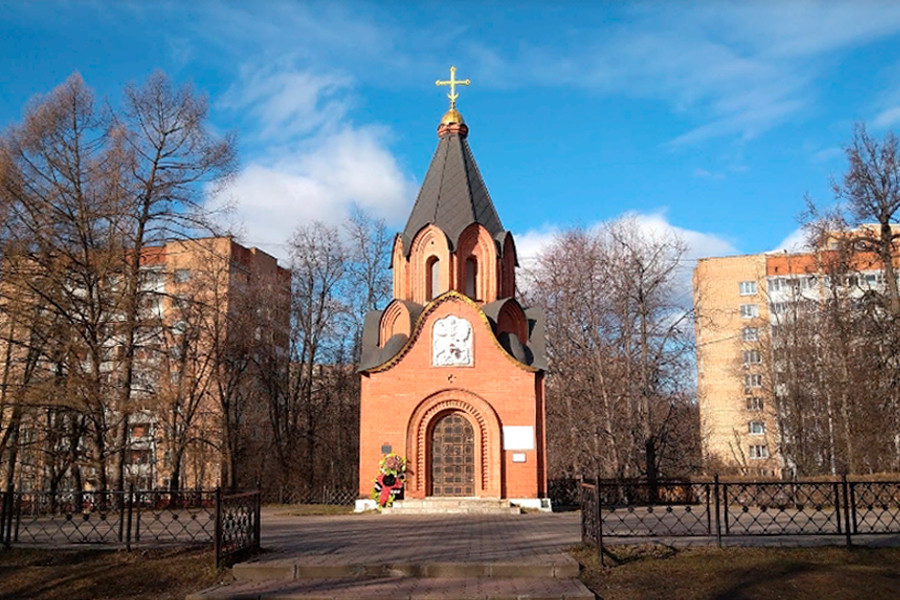
Chapel of the Transfiguration of the Savior in the Memorial Park complex of world war I heroes. Built in 1998
His second favorite place for photos is the small Berezovaya Roscha (“Birch Grove”) Park (renovated in 2020 as part of the ‘My district’ program), which, besides birches, is home to maple, ash, and linden trees.
Every visitor to Khodynka simply must go to the World War I Heroes Memorial Park at the Bratskoe (Fraternal) Cemetery, Lyubarsky insists.
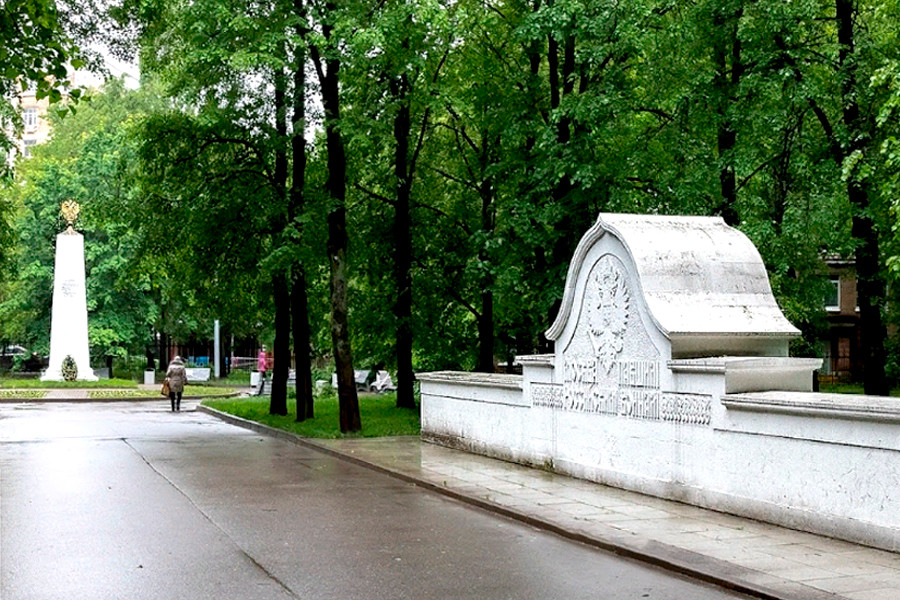
World war I Heroes memorial Park
“There’s a wonderful chapel with the buried ashes of Grand Duke Nikolai Romanov [the grandson of Nicholas I and an uncle of Nicholas II who was the Russian commander-in-chief during World War I]. Everything’s also very photogenic there,” says Lyubarsky.
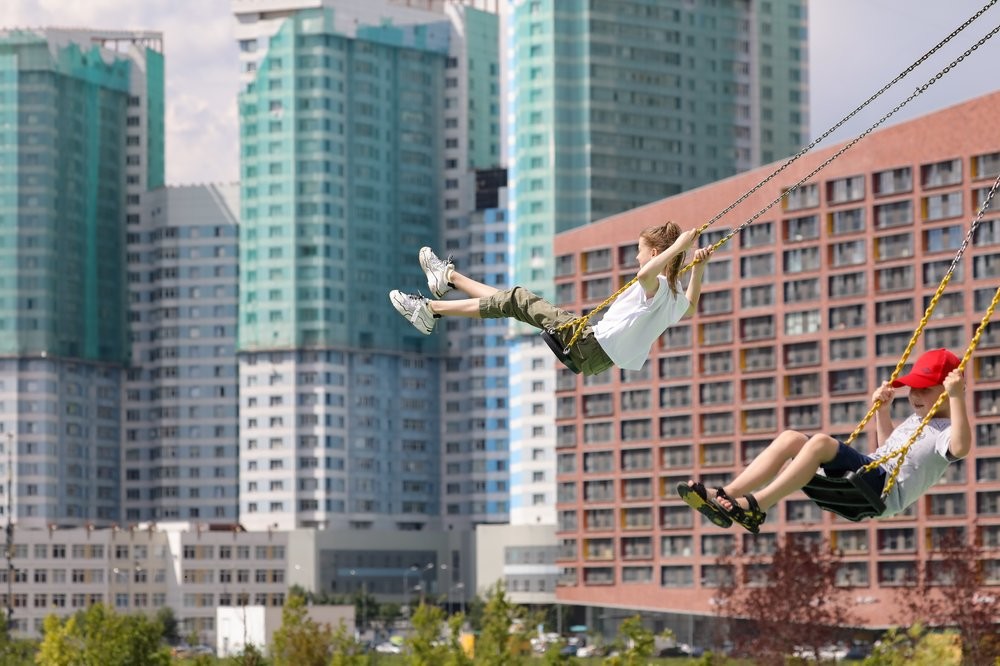
In his opinion, every foreign tourist should visit Khodynka for a glimpse of what the future Russia might look like.
“It would be good if all the suburbs could be like this. I’d love this to spread beyond the Moscow Ring Road [MKAD],” he concludes.
If using any of Russia Beyond's content, partly or in full, always provide an active hyperlink to the original material.
to our newsletter!
Get the week's best stories straight to your inbox
- 4 BEST short walks around Moscow (PHOTOS)
- 5 masterpieces of industrial architecture in Moscow (PHOTOS)
- 5 most BEAUTIFUL Moscow noble estates (PHOTOS)
This website uses cookies. Click here to find out more.

The 50 best parks and gardens in Moscow
Navigate forward to interact with the calendar and select a date. Press the question mark key to get the keyboard shortcuts for changing dates.
Navigate backward to interact with the calendar and select a date. Press the question mark key to get the keyboard shortcuts for changing dates.

1 Gorky Central Park of Culture and Leisure
2 Kolomenskoye

3 Tsaritsyno Museum-Reserve
4 all-russian exhibition center, 5 sokolniki park.

Track your travel spending and split costs with friends
Plan your trip. Keep your budget organized. Split the cost between tripmates. Wanderlog does it all.

6 Zaryadye Park
7 moscow zoo, 8 izmailovsky park, 9 muzeon park of arts, 10 neskuchny garden, 11 bauman garden, 12 park krasnaya presnya, 13 moscow state university, 14 vorobyovy gory, 15 family park skazka..

Don’t forget to pack anything
Stay organized with a to-do list, packing list, shopping list, any kind of list.

16 Nebo Trampoline park
17 happylon, 18 the rink, 19 fishpoint, 20 vorob'yevy gory, 21 moscow-850, park attraktsionov i razvlecheniy, 22 gulliver, 23 le parterre, 24 vorob'yevy gory, 25 apothecary garden.

All travel reservations in 1 place
Never dig through your emails again — access all your flights, lodging, and any reservations in 1 place.

26 Alexander Garden
27 kuskovo estate museum, 28 patriarch's ponds, 29 hermitage garden, 30 main botanical garden of the russian academy of sciences, 31 nudistskiy plyazh v serebryanom boru, 32 yekaterininskiy park, 33 city farm, 34 pokrovskoye-streshnevo park, 35 park ostankino.

Perfect for road trips
See time and distance between places, and optimize your route to get the most of your day.

Collaborate with friends in real time
Plan along with your friends with live syncing and collaborative editing.

46 Mitino landscape park
47 park druzhby, 48 lefortovo park, 49 trubetskoy estate, 50 park sadovniki, top searches in moscow, popular road trips from moscow, what's the weather like in moscow.
It depends on when you visit! We've compiled data from NASA on what the weather is like in Moscow for each month of the year: see the links below for more information.
- Weather in Moscow in January
- Weather in Moscow in February
- Weather in Moscow in March
- Weather in Moscow in April
- Weather in Moscow in May
- Weather in Moscow in June
- Weather in Moscow in July
- Weather in Moscow in August
- Weather in Moscow in September
- Weather in Moscow in October
- Weather in Moscow in November
- Weather in Moscow in December
All road trips from Moscow
- Moscow to London drive
- Moscow to Paris drive
- Moscow to St. Petersburg drive
- Moscow to Berlin drive
- Moscow to Prague drive
- Moscow to Amsterdam drive
- Moscow to Budapest drive
- Moscow to Vienna drive
- Moscow to Istanbul drive
- Moscow to Florence drive
- Moscow to Venice drive
- Moscow to Stockholm drive
- Moscow to Milan drive
- Moscow to Krakow drive
- Moscow to Copenhagen drive
- Moscow to Warsaw drive
- Moscow to Helsinki drive
- Moscow to Munich drive
- Moscow to Brussels drive
- Moscow to Tallinn drive
- Moscow to Riga drive
- Moscow to Oslo drive
- Moscow to Turin drive
- Moscow to Hamburg drive
- Moscow to Vilnius drive
- Moscow to Yaroslavl drive
- Moscow to Nizhny Novgorod drive
- Moscow to Kyiv drive
- Moscow to Tula drive
- Moscow to Bruges drive
Explore nearby places
- Likino-Dulevo
- Ivanteyevka
- Orekhovo-Zuevo
- Semyonovskoye
- Ivanovskoye
- Rumyantsevo
- Dzerzhinsky
- Sovkhoz Imeni Lenina
- Dolgoprudny
All related maps of Moscow
- Map of Moscow
- Map of Danki
- Map of Shatura
- Map of Likino-Dulevo
- Map of Uspenskoye
- Map of Gorskoye
- Map of Ivanteyevka
- Map of Reutov
- Map of Domodedovo
- Map of Peresvet
- Map of Vorobyovo
- Map of Bronnitsy
- Map of Orekhovo-Zuevo
- Map of Moskovsky
- Map of Semyonovskoye
- Map of Izmaylovo
- Map of Nikolskoye
- Map of Ivanovskoye
- Map of Marfino
- Map of Govorovo
- Map of Nagornoye
- Map of Mosrentgen
- Map of Bratsevo
- Map of Rumyantsevo
- Map of Mytishchi
- Map of Putilkovo
- Map of Razvilka
- Map of Khimki
- Map of Dzerzhinsky
- Map of Sovkhoz Imeni Lenina
- Map of Dolgoprudny
Moscow throughout the year
- Moscow in January
- Moscow in February
- Moscow in March
- Moscow in April
- Moscow in May
- Moscow in June
- Moscow in July
- Moscow in August
- Moscow in September
- Moscow in October
- Moscow in November
- Moscow in December
Looking for day-by-day itineraries in Moscow?
Get inspired for your trip to Moscow with our curated itineraries that are jam-packed with popular attractions everyday! Check them out here:
- 1-Day Moscow Itinerary
- 2-Day Moscow Itinerary
- 3-Day Moscow Itinerary
- 4-Day Moscow Itinerary
- 5-Day Moscow Itinerary
Best attractions in nearby cities
- Top things to do and attractions in Khimki
Best restaurants in nearby cities
- Where to eat: the best restaurants in Mytishchi
- Where to eat: the best restaurants in Khimki

- Itinerary + map in one view
- Live collaboration
- Auto-import hotels and reservations
- Optimize your route
- Offline access on mobile
- See time and distance between all your places
- Hispanoamérica
- Work at ArchDaily
- Terms of Use
- Privacy Policy
- Cookie Policy
Moscow's Urban Movement: Is There Hope for a Better Future?

- Written by Mari Chichagova
- Published on December 09, 2015
In 2010, following the election of a new mayor, the Moscow city government began to work towards a comfortable urban environment in which citizens would feel like residents rather than mere users of the city. The emphasis was on creating public spaces in which Muscovites could fulfill their potential and feel that the city was their home.
Gorky Park was at the forefront of the changes. During the 1990s, the "Central Park of Culture and Leisure" accumulated a collection of fairground rides and became a sort of amusement park popular principally among visitors from other cities; Muscovites hardly went there. Three years ago, the city government made it their mission to overturn the park's image and bring Moscow's residents back. A full-scale reconstruction and restoration began in spring 2011.
Today, Gorky Park is a new level of urban space – one centered around people and boasting a scrupulously conceived infrastructure. All of the changes were aimed at creating a comfortable environment for life - for strolling and sport, work and study, culture and leisure. Moreover, in a short time the park has developed an effective economic model whereby it receives one half of its budget from the city and generates the other half itself.

The regeneration of Gorky Park was followed by a flurry of changes. The city began to invest intensively in the development of other Moscow parks (by 2015, 240 new parks had been opened, 160 of which were in residential areas), in cycling mobility and infrastructure (by 2015, 241.7 kilometers of cycle track and around 10,000 bike parking spaces had been installed), and in street design and refurbishment (to date, 50 streets and squares have been repaired and 72 pedestrian zones created). Pedestrians are now the priority user group in the urban environment.
The work undertaken in 2015 has been more than impressive in its scale: sidewalks have been widened; 30,000 trees have been planted; 10,000 unauthorized advertising structures have been demolished; the facades of 943 buildings have been repaired, 178 hectares of lawn have been replanted, and 1.1 million square meters of flowerbed have been arranged and planted.

The redevelopment of Krymskaya embankment , completed in 2013, is one of the most successful projects to be implemented in recent years. In accordance with the design by Wowhaus Architecture Bureau , the embankment was completely pedestrianized. Cycle paths were demarcated and later became part of a single 8 kilometer cycle track along the Moskva River linking the Pushkinskaya, Andreevskaya, and Vorobyovskaya embankments. The historical identity of the area was also taken into account: artists have sold their work on the Krymskaya embankment since Soviet times; in light of the tradition, a covered wooden arcade was built to accommodate them. Nearby, a summer cinema and a lecture theater have sprung up. Meanwhile, plentiful benches were installed, along with an open fountain which has become a favorite spot for both locals and tourists.
Triumfalnaya square, which opened in its new guise in September 2015, is another successful urban project. As part of the reconstruction, vehicular access to the square was blocked, the street-level parking was removed, and the section of road from the Garden ring onto Tverskaya Street was closed off. The concept, by the architecture studio Buromoscow , was selected as part of a competition which attracted over forty entries. The design also included new trees, swings, and benches, as well as pavilions where residents and tourists might buy tea, coffee and a newspaper, or find out information about the city.

Despite the obvious positive dynamic - Moscow's gradual transition from a city of disconnected “islands” with a closed, unfriendly urban environment to a European style city where pedestrians are the priority user group - there remain a plethora of issues.
Yes, Moscow is continually holding round tables, forums, and discussions of its future urban development. Yes, it can now be said that the government has long-term planning objectives and a concept for how the city ought to look in three, five or ten years’ time.
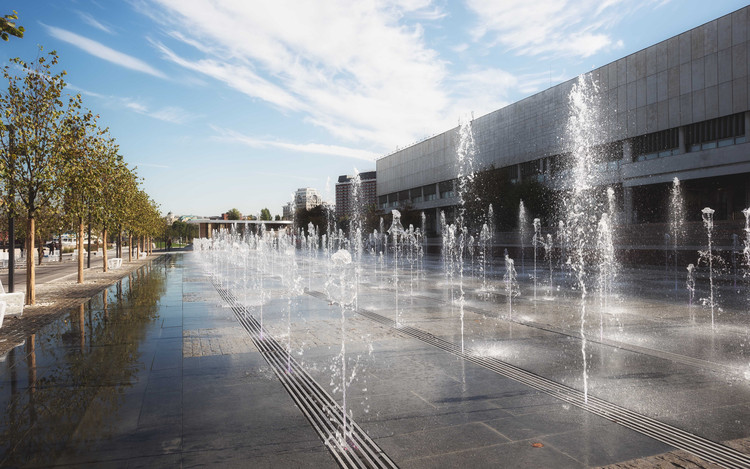
And yet - despite the involvement of world class experts such as Jan Gehl , Renzo Piano , and Diller Sconfidio + Renfro , despite the numerous architectural competitions involving a jury, the expert community, and the citizens themselves - the quality and implementation of this city-scale project leaves much to be desired.
A good illustration of this is the Moscow government's ongoing program "My Street," which is intended to improve Moscow's public spaces. The project sets aside 100 billion roubles for the redevelopment of 4,000 streets by 2018. Nevertheless, the quality of the work carried out over the summer of 2015 (scheduled for completion in time for the Moscow City Day celebrations in early September) was far from ideal. After the hurried redevelopment works, it was hard not to notice the high, unwieldy curbs, the drains appearing unexpectedly in the middle of cycle-tracks, the tarmac laid on top of paving slabs, or the paving slabs laid on top of tarmac.

Often, an important date (such as the 2018 FIFA World Cup or City Day) is the best motivation for civil servants to get things done. But should it be that way?
There is a flip-side to chasing after statistics. Firstly, quality of execution suffers. Secondly, the choice of contractor and the professionalism of the people hired to supervise and implement the work leaves much to be desired.
The absence of professionals with the skills, experience and enthusiasm to finish a project to a high standard is becoming increasingly apparent. The contractors' main concern is currently to finish the work as fast as possible (usually to a low standard) and pick up their pay check. Companies rarely invest in skilled personnel, preferring to hire cheap labor.

The winners of architectural contests should be permitted, at a legislative level, to supervise the realization of their spatial development concepts. If this is not done, then contracting organizations will continue to profiteer and to alter concepts at the master-planning stage, condemning the original designs to remain mere ideas, a collection of pretty architectural renders in the official documentation. If third parties continue to oversee work, as opposed to the authors of the concepts, then the question must be answered: how will the quality of future projects be guaranteed?
There is no doubt about the mayor's desire to invest in the visual face of Moscow and to improve the city's quality of life. Yet the need remains for a more careful approach to project implementation and to hiring and contracting decisions. There also needs to be more active work with citizens - they are the main users of urban space, and they, ultimately, are the clients.

Mari Chichagova graduated with honours degree from the Faculty of Philology of Lomonosov Moscow State University in 2009. In 2010 she started working at "Interior + Design," a magazine dedicated to architecture, design, culture and about people who were defining and driving those processes, from Norman Foster to Le Corbusier and Zaha Hadid. Afterwards she worked as a PR specialist at the Strelka Institute of Media, Architecture and Design , a Russian institution that is working in the field of urban studies, using a multi-disciplinary approach.
Since 2013 she has worked as a Deputy PR Director and then as an Acting PR Director at Gorky Park , Moscow ’s Central park. In addition to PR duties, she initiated contacts with other significant parks and organizations around the globe such as International Federation of Parks and Recreation Administration, the San Francisco Golden Gate Park, San Francisco Recreation and Park Department, Central Park of New York among others.
All images of Gorky Park (excluding image of Garage Museum) via Shutterstock.com
- Sustainability
世界上最受欢迎的建筑网站现已推出你的母语版本!
想浏览archdaily中国吗, you've started following your first account, did you know.
You'll now receive updates based on what you follow! Personalize your stream and start following your favorite authors, offices and users.
- International edition
- Australia edition
- Europe edition
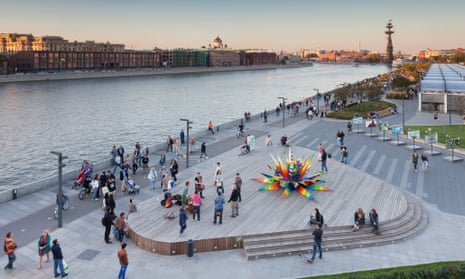
'Things have started to improve': Moscow residents share thoughts on the city's changes
From cycling infrastructure to public spaces, how do Moscow’s residents feel about the city’s urban renewal projects? Here they share their stories
The ‘Moscow experiment’ has seen the city undergo renewal efforts over the last five years to improve liveability. But what do Moscow’s residents really think about the changes? We asked you to share your stories of life in the Russian capital, and reflect on whether Moscow is changing for better or worse.
The city centre may be seeing improvements in infrastructure and public space, but what about the suburbs? How involved have local citizens been in the changes? And what does the future hold for Moscow? We’ve rounded up a selection of your GuardianWitness contributions , comments and emails, which reveal the everyday experiences of Moscow’s transformations:
About pedestrians and automobilists
Moscow has undergone massive change in the last five years, but the most obvious developments concern parks, streets, and general navigation in the capital. Most of the developments are surely positive: the city has seemed to get more air. There have appeared more walking paths, pedestrian zones have been expanded, some streets have been closed for traffic altogether, parks are being renovated, and new bicycle lanes are being offered now to city residents and its guests. However, there are negative changes as well, which have largely affected car owners: extension of the paid parking areas, and the increase of the average price, the need to navigate a bypass route in order to drive round pedestrian zones. But this coin has another side too: fewer cars in the centre means less exhaust fumes and cleaner air. Muscovites look forward to the old parks being renovated, and the new ones being opened. New plans make excited everyone: new metro stations, new roads, new bicycle lanes and pedestrian footpaths.
It's changing for better
Moscow is definitely changing for better now. As I see it, the authorities are trying to make a city a better place to live in, especially in remote residential neighborhoods, which is very good. Many parks were renovated, cycle lanes appeared. Moscow has become a nice place for long walks and cycling. The city has a lot to offer now including museums, and different events like exhibitons, summer outside activities and others. It's a pity that it takes so long but taking into account the size of the city and its population I can say the situation has changed even if compared to what it was like 4-6 years ago.
I grew up in Moscow and lived here until two years ago. My general impression is that the people making the decisions are trying to copy some European practices like bike rental, parks, etc, but the general success is limited. The streets still belong to drivers, not to pedestrians, to an unbelievable extent. Another thing is that street retail was banned in an attempt to improve the city. It works for the city centre, where retailers really spoiled the overall impression of the scene, but 80% of Moscow is not a city centre. And there, this removal makes your life more difficult. The positive trend is all these multiple festivals, exhibitions, etc, but the best of all these events were initiated by citizens, so I would say that it is due to improving integration of Muscovites into the global world. Overall, I should admit that I love my homeland, but there is still a far way to go to make the city as comfortable as it could be, and the incentives of the people in charge in many cases do not have a lot to do with the wellbeing of Muscovites. - Ekaterina Ivanova
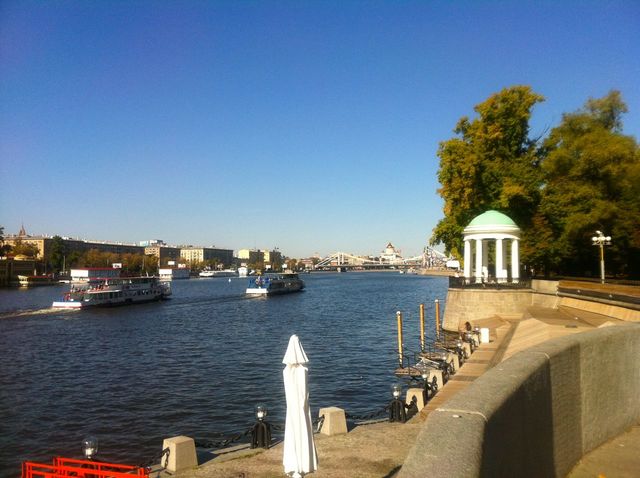
In the city
Gorky central park of culture and leisure
Better, definitely.
I was born in Moscow, emigrated to the UK ten years ago, and have been coming back at least once a year ever since. Although it's hard to tell from only a short visit, I can definitely see improvement in the capital: public transport operates better, local government services are better organised, the streets are cleaner... in my old neighbourhood (a very working-class, high-immigrant community), there are more 'high-street' shops appearing, less potholes on the roads, new playgrounds, new trees being planted and even the occasional fountain being built. These things may seem little and shallow, but I can certainly see improvement in this sense, at least.
It’s better on the surface, but still has inclusion and institutional issues. What do I mean? I mean that no one really asked us, Moscow residents, about the changes being made in the city (although we really welcome a big part of them). And lack of inclusion and mutual trust between the residents is in the end the main problem of Moscow as a city and a community (in my opinion). You can build as much fancy stuff as the money allows you to but if the Muscovites do not trust each other and don’t consider this city to truly belong to them, it will never become a real city and will continue to exist as “a big village” with fancy parks, craft beer and bicycle service. - Sergey Kurakov

When you smiling
Moscow is beautiful with the history, but it's even more beautiful when history meets modern cultural programmes. This installation is a part of one of them. Such things can be seen in the city when we have holidays
The transformation of Gorky park was nice but it is now overly popular which means it is not so pleasant to go to. The boulevard ring has in the main been transformed and makes for a pleasant walk. The banks of the Moskva have been transformed and the walk from Red October down to Gorky park is now interesting, however I always feel that Moscow does not make as much as it's river as other cities (Paris or London for example) do. The area around modern tretyakov could be transformed into an area more like the south bank.
However the biggest killer of Moscow life are simply the size of the roads. They are everywhere and take priority over pedestrians. To really improve Moscow life would be deal with the massive structural change required for dealing with traffic. And that, unfortunately, costs more than plants.
I was born in Moscow and truly love it. And this city inspired me to take an urban planning course: I honestly just couldn’t figure out how one of the wealthiest cities in the whole world could experience such a plethora of problems ranging from car invasion to banal low visual and urban design culture. Many things have changed for the better. A lot of new creative things emerged, such as anti-cafes, high-quality bars and famous Moscow art-clusters. These all influence the city and make it somewhat more democratic. On top of that, there are more direct influences on its physical fabric due to new urban design studios like StrelkaKB, Wowhaus and many others. However, the overall system is still underdeveloped. Moscow is not really clean, it is over-reliant on cars and it seems not much action is taken to improve that; it’s incredibly unfriendly to wheelchairs and people of similar mobility. We still get enormous unnecessary shopping malls planted close to the centre. Moscow is a wonderful city and sure enough it is gradually developing, however, only in a discrete, tactical way, largely and mostly driven by private interests. The public sector, in turn, seems to provide no clear strategic policy to turn Moscow in a healthy modern democratic city with all its problems tackled in one way or another. - dmitryBooM
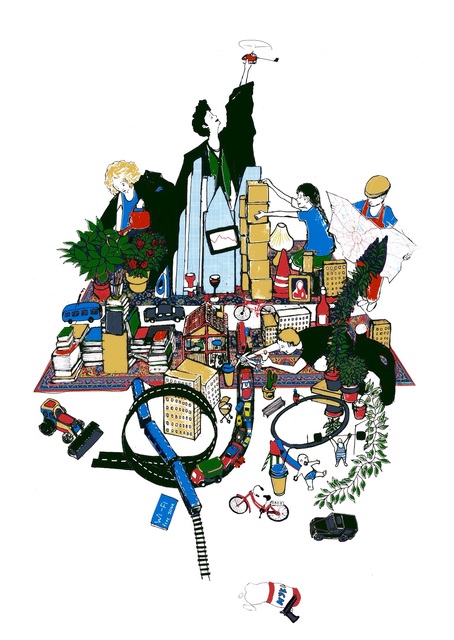
Comments (…)
Most viewed.
Urban Greening as a Response to Societal Challenges. Toward Biophilic Megacities (Case Studies of Saint Petersburg and Moscow, Russia)
- First Online: 17 March 2023
Cite this chapter

- Diana Dushkova 8 ,
- Maria Ignatieva 9 &
- Irina Melnichuk 10
Part of the book series: Cities and Nature ((CITIES))
720 Accesses
The population density in megacities is continuously increasing, resulting in a reduction of green spaces and a deterioration in the urban environment quality. Urban green is often being replaced by parking places, shopping centers, and service enterprises. This chapter examines the efforts of two megacities in Russia—Moscow and Saint Petersburg—to organize sustainable greening solutions for their residential areas using new achievements in landscape design theory and practice, such as the concept of the biophilic city. The chapter analyzes the history of greening strategies and discusses the concept of urban green infrastructure and its implementation in both Russian megacities. The chapter presents an assessment of the current state of urban green spaces and the most recent master plans and how these cities are facing and responding to modern societal challenges. The results of an analytical review of the most successful urban greening projects in Moscow and Saint Petersburg are presented as well. The economic and climatic features of the urban green areas and their architectural and planning features are considered, along with strategies for further development of the urban green spaces in both cities, aiming to address the new principles of biophilic cities.
This is a preview of subscription content, log in via an institution to check access.
Access this chapter
- Available as PDF
- Read on any device
- Instant download
- Own it forever
- Available as EPUB and PDF
- Compact, lightweight edition
- Dispatched in 3 to 5 business days
- Free shipping worldwide - see info
- Durable hardcover edition
Tax calculation will be finalised at checkout
Purchases are for personal use only
Institutional subscriptions
Aleksandrova S (2013) Sustainability principles for St. Petersburg landscape with Scandinavian experience in mind: application of Swedish green space research result of “the eight characteristics”. Master’s thesis, 30 hec, Advanced level, A2E Landscape Architecture—master’s programme, Alnarp
Google Scholar
Archive Buro of Moscow (2018) Holiday of liberated labor: the first subbotniks in the capital. https://www.mos.ru/news/item/9998073/ . Accessed 10 Jan 2019
Archive Committee of Saint Petersburg (2019) Archive Committee of Saint Petersburg. https://spbarchives.ru/ . Accessed 10 Jan 2019
Beatley T (2010) Biophilic Cities: Integrating Nature into Urban Design and Planning. Island Press, Washington, DC
BioDAT (2005) Moscow—the Lotten capital of the XXI century. http://biodat.ru/db/birds/sol2005.htm . Accessed 10 Jan 2019
Breuste JH, Qureshi S, Xue F (2015) Urban ecosystems: functions, services and sustainable management. Ecocity Green Build 42–52
Bunin AV (1953) Istoriya gradostroitelnogo iskusstva (History of urban planning). Gosudarstvennoje Izdatel’stvo Literatury po stroitel’stvu i Arhitekture. Moscow (in Russian)
Bunin AV, Ilyin LA, Polyakov NH, Shkarikov VA (1945) Gradostroitel’stvo (Urban planning). Izda-tel’stvo Akademii Arhitektury SSSR, Mosow (in Russian)
DEMP – Department for Environmental Management and Protection (2018) Norms and rules for the design of objects of non-traditional types of gardening in the city of Moscow (un-published). Available at: http://www.dpioos.ru/eco/ru/activity/n_160/o_13279 . Accessed 20 Oct 2018
Dushkova D, Krasovskaya T (2018) Post-Soviet single-industry cities in northern Russia: movement towards sustainable development. A case study of Kirovsk. Belgeo (on-line). Revue Belge De Géographie 4:1–25. https://doi.org/10.4000/belgeo.27427
Article Google Scholar
Dushkova D, Haase D, Haase A (2016) Urban green space in transition: historical parks and Soviet heritage in Arkhangelsk, Russia. Crit Housing Anal 3(2):61–70. https://doi.org/10.13060/23362839.2016.3.2.300
Federal Russian Government (1995) Federal Law of Russia No. 33 “On specially protected natural territories” from 14.03.1995. www.oopt.info . Accessed 21 Dec 2018 (in Russian)
Genplan Moskvy (Masterplan Moscow) (1935) O generalnom plane rekonstrukcii Moskvy (About the general plan for the reconstruction of Moscow). Partizdat, Moscow (in Russian)
Goretskaya A (2017) Toporina V (2017) The ecological framework of the city. Three pillars of landscape architecture: design, planning and management. New visions. In: Ignatieva M, Melnichuk I (eds) Conference proceedings. Saint-Petersburg State Polytechnic University, Polytechnic University Publishing House, Saint-Petersburg, pp 23–24
Haase D (2017) Urban ecosystem, their services and town planning. Crit Reflecti Sel Shortcomings. URBANISTICA 159:90–94
Haase D, Dushkova D, Haase A, Kronenberg J (in press) Green infrastructure in post-socialist cities: evidence and experiences from Russia, Poland and Eastern Germany. In: Tuvikene T, Sgibnev W, Neugebauer CS (eds) Post-socialist urban infrastructures. Taylor & Francis/Routledge, UK
Ignatieva M (1997) The mystery of ancient Russian gardens. Lustgarden. J Swedish Soc Dendrol Park Cult 69–78
Ignatieva M (2010) Design and future of urban biodiversity. In: Müller N, Werner P, Kelcey J (eds) Urban biodiversity and design. Wiley-Blackwell, Oxford, pp 118–144
Chapter Google Scholar
Ignatieva M (2013) Historic gardens—where nature meets culture—can be urban biodiversity hotspots. The nature of cities. https://www.thenatureofcities.com/2013/01/27/historic-gardens-where-nature-meets-culture-can-be-urban-biodiversity-hotspots/ . Accessed 22 Oct 2018
Ignatieva M, Ahrné K (2013) Biodiverse green infrastructure for the 21st century: from “green desert” of lawns to biophilic cities. J Archit Urban 37(1):1–9
Ignatieva M, Konechnaya G, Stewart G (2011a) St. Petersburg. In: Kelcey J, Müller N (eds) Plants Habitats Eur Cities. Springer Science & Business Media, pp 407–452
Ignatieva M, Stewart GH, Meurk C (2011b) Planning and design of ecological networks in urban areas. Landscape Ecol Eng 7:17–25
Ignatieva M, Murray R, Waldenström H (2015) Can large parks be urban green saviors? The nature of cities. https://www.thenatureofcities.com/2015/12/03/can-large-parks-be-urban-green-saviors/ . Accessed 28 Oct 2018
Ignatieva M, Golosova E, Melnichuk I, Smertin V (2018) Development of biophilic cities in Russia: from ideal scientific town and Ecopolis to the green strategy of the modern mega-polis. In: IFLA World Congress Singapore proceedings, Singapore, 2018. http://www.ifla2018.com/eproceedings
Kabisch N, Korn H, Stadler J, Bonn A (2017) Nature-based solutions to climate change adaptation in urban areas. Springer International Publishing, Cham. https://doi.org/10.1007/978-3-319-56091-5
Kartinki24.ru (2019) Vasily Polenov. Moscow courtyard. http://www.kartinki24.ru/kartinki/art/16906-vasiliy-polenov-moskovskiy-dvorik.html . Accessed 10 Jan 2019
Khodakov Y (1986) Gorodskoje Ozelenenije (The urban greenery). Lenisdat, Leningrad (in Russian)
Klimanova OA, Kolbovsky EY (2013) Protected areas in the system of territorial planning and functional zoning of the Moscow city. Regional Geoecol Issues 177–180 (in Russian)
Kochurov BI, Ivashkina IV (2015) Urban Landscapes of Moscow and their spatial transformation. Ecol Urban Areas 2:48–54
Korzhev MP (ed) (1954) Ozelenenije sovetskih gorodov: Posobie po Projektirovaniju (Greening of Soviet cities: Green projects Manual). Gosudarstvennoje Isdatelstvo literaturi po stroitelstvu i architecture, Moscow (in Russian)
Melnichuk I (2017) St. Petersburg green infrastructure and methods of its formation. In: Igna-tieva M, Melnichuk I (eds) Three pillars of landscape architecture: design, planning and management. New visions. Conference proceedings, Saint-Petersburg State Polytechnic University, 2017. Polytechnic University Publishing House, Saint-Petersburg, pp 105–112
Minin AA (2014) Sustainable development and ecosystem services of natural areas of Moscow. Bulletin Towards Sustain Devel Russia 69:2–9
Moscow city council (1999, with modifications of 2014) Moscow law on the protection of green areas. http://docs.cntd.ru/document/901734936 . Accessed 21 Dec 2018 (in Russian)
Mosecomonitoring (2017) The state reports of department of environmental management and environmental protection of Moscow for 2016. Mosecomonitoring, Moscow. http://mosecom.ru/reports/2014/report2014.pdf . Accessed 28 Oct 2018 (in Russian)
Mosgorstat Moscow (2018) Moscow city committee of statistics by Russian Federal State statistics service. About demographic, economic and social situation in Moscow in 2018. http://moscow.gks.ru/wps/wcm/connect/rosstat_ts/moscow/ru/statistics/population/ . Accessed 26 Oct 2018 (in Russian)
Müller N, Werner P (2010) Urban biodiversity and the case for implementing the convention on biological diversity in towns and cities. In: Müller N, Werner P, Kelcey (eds) Urban biodiversity and design. Blackwell Publishing, pp 1–33. https://doi.org/10.1002/9781444318654.ch1
Nilsson K, Åkerlund U, Konijnendijk van den Bosch C, Alekseev A, Caspersen O, Guldager S, Kuznetsov E, Mezenko A, Selikhovkin A (2007) Implementing urban greening aid projects—the case of St. Petersburg Russia. Urban for Urban Green 6:93–101. https://doi.org/10.1016/j.ufug.2007.01.004
Pauleit S, Olafsson AS, Rall E, van der Jagt A, Ambrose-Oji B, Andersson E, Anton B, Buijs A, Haase D, Elands B, Hansen R, Kowarik I, Kronenberg J, Mattijssen T (2018) Urban green infrastructure in Europe—status quo, innovation and perspectives. Urban for urban green. Rosstat 2017. Federal State statistics service. Russia 2016—Statistical pocketbook, Moscow
Petrostat (2018) Department of Federal State Statistics Service of St. Petersburg and Leningrad region. About demographic, economic and social situation in Saint Petersburg in 2018. http://petrostat.gks.ru/wps/wcm/connect/rosstat_ts/petrostat/ru/statistics/Sant_Petersburg/ . Accessed 26 Oct 2018 (in Russian)
Research and Project Institute of Moscow City Master plan (2018) Research and Project Institute of Moscow City Master plan. https://genplanmos.ru . Accessed 10 Jan 2019
Seto K, Reenberg A (eds) (2014) Rethinking global land use in an urban era. Struengmann forum reports, vol 14. Julia Lupp, series editor, MIT Press, Cambridge, MA
Shumilova OV (2016) Methods of St. Petersburg Green Infrastructure formation. St. Petersburg State Forest Techical University, St. Petersburg (in Russian)
St. Petersburg city council (2004, with modifications of 2010) St. Petersburg law on the protection of green areas. http://pravo.gov.ru/proxy/ . Accessed 05 Jan 2019 (in Russian)
State Research and design center of Saint Petersburg Masterplan (2018) State Research and design center of Saint Petersburg Masterplan. http://www.gugenplan.spb.ru . Accessed 10 Jan 2019
Totalarch (2019) Regular gardens of Peter's time. Regular style evolution and later baroque mid-18th century. http://landscape.totalarch.com/russian_gardens/baroque . Accessed 10 Jan 2019
Vasenev I, Dovletyarova E, Chen Z, Valentini R (2017) Megacities 2050: Environmental con-sequences of urbanization. In: Proceedings of the VI international conference on landscape architecture to support city sustainable development. Springer International Publishing. https://doi.org/10.1007/978-3-319-70557-6
Weiner DR (2002) A little corner of freedom: Russian nature protection from Stalin to Gorbachev. University of California Press
WHO—World Health Organisation (2017) Urban green space interventions and health: a review of impacts and effectiveness. Full report. WHO Regional Office for Europe, Copenhagen. http://www.euro.who.int/__data/assets/pdf_file/0010/337690/FULL-REPORT-for-LLP.pdf?ua=1 . Accessed 20 Dec 2018
Yanitsky O, Usacheva O (2017) History of the “Green City” in Russia. J Culture Art Res 6(6):125–131. https://doi.org/10.7596/taksad.v6i6.1330
Zemvopros.ru (2019) The master plan of St. Petersburg 2015–2025. Functional area map. https://www.zemvopros.ru/genplan.php . Accessed 10 Jan 2019
Download references
Acknowledgements
This work was supported by the Russian Foundation for Basic Research (RFBR) project “Mathematical-cartographic assessment of medico-ecological situation in cities of European Russia for their integrated ecological characteristics” (2018–2020) under Grant number No 18-05-406 00236/18 and by the Horizon 2020 Framework Program of the European Union project “Connecting Nature” under Grant Agreement No 730222.
Author information
Authors and affiliations.
Department Urban and Environmental Sociology, Helmholtz Centre for Environmental Research - UFZ, Permoserstraße 15, Leipzig, 04318, Germany
Diana Dushkova
School of Design, University of Western Australia, Stirling Highway 35, Perth, 6001, Australia
Maria Ignatieva
Faculty of Landscape Architecture, Saint Petersburg State Forest Technical University, Institutskij pereulok 5, St.-Petersburg, 194021, Russia
Irina Melnichuk
You can also search for this author in PubMed Google Scholar
Corresponding author
Correspondence to Diana Dushkova .
Editor information
Editors and affiliations.
Department of Geography and Geology, University of Salzburg, Salzburg, Austria
Jürgen Breuste
Landscape Change and Management, Leibniz Institute of Ecological Urban and Regional Development, Dresden, Sachsen, Germany
Martina Artmann
Center for Environmental Research and Impact Studies, University of Bucharest, Bucharest, Romania
Cristian Ioja
Department of Geography (Landscape Ecology), Humboldt University of Berlin, Berlin, Germany
Salman Qureshi
Rights and permissions
Reprints and permissions
Copyright information
© 2023 Springer Nature Switzerland AG
About this chapter
Dushkova, D., Ignatieva, M., Melnichuk, I. (2023). Urban Greening as a Response to Societal Challenges. Toward Biophilic Megacities (Case Studies of Saint Petersburg and Moscow, Russia). In: Breuste, J., Artmann, M., Ioja, C., Qureshi, S. (eds) Making Green Cities. Cities and Nature. Springer, Cham. https://doi.org/10.1007/978-3-030-73089-5_25
Download citation
DOI : https://doi.org/10.1007/978-3-030-73089-5_25
Published : 17 March 2023
Publisher Name : Springer, Cham
Print ISBN : 978-3-030-73088-8
Online ISBN : 978-3-030-73089-5
eBook Packages : Earth and Environmental Science Earth and Environmental Science (R0)
Share this chapter
Anyone you share the following link with will be able to read this content:
Sorry, a shareable link is not currently available for this article.
Provided by the Springer Nature SharedIt content-sharing initiative
- Publish with us
Policies and ethics
- Find a journal
- Track your research

Mission Moscow : A Conversation with Evgeny Kozlov
Mr. Evgeny Kozlov, Deputy Head Mayor of Moscow Government and Chairman of the Moscow City Tourism Committee, who has come to the city to attain BLTM, the annual prestigious travel event at the Leela Ambience Convention Centre, Delhi spoke with TW Editor Anirban Dasgupta on his vision and goal with the all-new tourism initiatives in Moscow.
The bond between India and Russia has a long history of culture, literature, love, and of course politics. But recently, there has also been a lot of talk about Gastronomical tourism. Any personal experience with this?
My personal take on the bond between India and Russia stems from my recent experience of trying authentic Indian cuisine in Moscow. I thoroughly enjoyed the spicy flavours of the Curry dish I tried and it left a lasting impression on me. This made me appreciate the cultural exchange between our two countries even more. I believe that Moscow, being a culinary hub, is a great place for people from all over the world, including Indian visitors, to immerse themselves in our rich history and culture. It’s a unique experience that brings people together and showcases the diversity of the gastronomic universe. Moscow has a thriving food scene with various international cuisines to explore, from Chinese to South African and Latin American. This culinary diversity reflects the open-mindedness and curiosity of the Russian people when it comes to trying new types of food. Moscow truly has something for everyone, and I encourage Indian tourists to come and indulge in this gastronomic journey.

How optimistic are the post-pandemic recovery figures?
After the Covid-19 pandemic, we have witnessed a remarkable recovery in tourism in Moscow. In fact, we have been able to restore 90% of the pre-pandemic tourist flow. In the first half of 2023, almost a million foreign tourists visited Moscow, with over 600,000 of them arriving during the summer season. Among the non-CIS countries, China has led the way in terms of tourist traffic, followed by Iran, the United Arab Emirates, Turkey, and India. Prior to the pandemic, India’s tourist flow was steadily growing at a rate of 12-15% annually. Although we faced challenges during the pandemic, we have now put in place all the necessary conditions for a successful recovery. Moscow is known for hosting numerous international exhibitions, forums, congresses, and conferences, attracting approximately 3.6 million business visitors in the past year alone. Among these visitors, India ranks third in terms of foreign business tourists in Moscow. To further promote tourism, we have initiated the MICE Ambassadors training program in India, which aims to assist Indian businesses in exploring opportunities and selecting relevant events in Moscow.
Can you please share your vision for future tourism development in Moscow?
Thank you for asking this question. I have a multi-faceted vision for the future tourism development in Moscow.
Firstly, I believe that tourism should provide a personal and authentic experience for each individual. Therefore, customization of experiences is crucial. For business tourists, we aim to offer special infrastructure facilities that cater to their specific needs and requirements. We are closely collaborating with infrastructure providers to ensure seamless experiences for those visiting Moscow for business purposes. On the other hand, when it comes to leisure or family tourists, we recognize the importance of providing a support system and guidelines for those traveling with their families, especially children. We are working with museums, theatres, and restaurants to customize their services and products to cater to tourists of all ages, including children. Furthermore, I envision rearranging tourism in Moscow to encourage visitors to delve into the history and heritage of our country. A significant part of my tourism goal is to motivate and inspire the youth and younger generations to travel to Russia. This involves providing affordable pricing for accommodations, entertainment, museums, and other attractions.
We are already constructing tailor-made infrastructure that specifically targets the young generation in Russia, and by next year, we plan to extend and promote these offerings to international young visitors as well. By rebranding the image of Moscow as a destination for longer stays, relaxation, and enjoying various facilities, we aim to change the perception that it is merely a transit or stop-over city. Lastly, the beautiful weather in Moscow during the summer months provides an opportunity to create delightful memories for tourists. I want every visitor to experience the sunshine, green landscapes, parks, cafes, restaurants, swimming pools, and sports facilities that Moscow has to offer during this time.
In summary, my vision for the future of tourism in Moscow revolves around creating customized travel experiences for every type of traveller.
How do you prioritize sustainability and responsible tourism practices in the development of business tourism?

How easy or difficult is it to get a Visa for an Indian Tourist at present?
Acquiring a Visa for Indian tourists has become easier with the introduction of the e-visa system. Since its launch in August 2023, more than 30,000 tourists have already utilized this system. The e-visa offers several advantages over traditional visas, such as avoiding the need to visit consulates or embassies. The application process only requires a digital photograph and a scan of the passport data page. The e-visa has a validity period of 60 days from the date of issuance, with a maximum stay of 16 days in Russia. This convenient and streamlined process is available to citizens of 55 countries, including India. Indian tourists are currently ranked third in terms of business travellers from outside the CIS countries visiting Moscow.
Author: Anirban
Share article, related news.

BLTM 2023 showcases top destinations for Bleisure and MICE Travel

École Ducasse Abu Dhabi Studio, in partnership with Erth Hospitality, to open this December
No comment be the first one., leave a reply cancel reply.
Your email address will not be published. Required fields are marked *
Save my name, email, and website in this browser for the next time I comment.
Mobile Menu Overlay
The White House 1600 Pennsylvania Ave NW Washington, DC 20500
WHAT THEY ARE SAYING: President Biden Expands San Gabriel Mountains National Monument and Berryessa Snow Mountain National Monument
As part of the Biden-Harris Administration’s unprecedented commitment to protect America’s natural wonders for future generations, honor areas of cultural significance to Tribal Nations and Indigenous peoples, and expand access to nature, yesterday President Biden signed proclamations expanding the San Gabriel Mountains National Monument and the Berryessa Snow Mountain National Monument. Together, these actions protect nearly 120,000 acres of lands in California.
The Biden-Harris Administration has already conserved more than 41 million acres of lands and waters, putting President Biden on track to conserve more lands and waters than any President in history.
Leaders from California and across the country praised the announcement. Here’s what they’re saying:
Tribal and Community Leaders
Anthony Roberts, Chairman, Yocha Dehe Tribe: “We thank President Biden for expanding the Berryessa Snow Mountain National Monument and protecting Molok Luyuk, an area steeped in thousands of years of rich history and profound meaning to the Patwin people, whose traditional territory stretches south from these hills to the shores of San Pablo Bay and east to the Sacramento River. Elements of the natural landscape on the ridge have traditional cultural significance to us. We look forward to the day when condors fly over Molok Luyuk once again.” [Statement, 05/02/2024]
Lynn Valbuena, Chairwoman, San Manuel Band of Missions Indians : “The San Manuel Band of Mission Indians is grateful for President Biden’s action today to expand the San Gabriel Mountains National Monument. The San Gabriel Mountains are culturally significant to the Serrano and other Indigenous peoples. It feels good to know that these mountains and lands will now be protected for future generations of our people.” [Statement, o5/02/2024]
Rudy Ortega Jr., L.H.D., President, Fernandeño Tataviam Band of Mission Indians: “We are thrilled that the San Gabriel Mountains National Monument is expanding. We thank the Biden administration for making this longstanding vision a reality. Expanding the Monument helps protect lands of cultural importance to my people who are part of this nation’s history and who have cared for these lands since time immemorial. It also further protects areas that are critical for our environment and the wildlife and plants that depend on this landscape.” [Statement, 05/02/2024]
Chief Anthony Morales, Gabrieleno San Gabriel Band of Mission Indians: “We add our voices in celebration of expanding the San Gabriel Mountains National Monument. The San Gabriel Mountains are historically significant to our tribe, our people, and our culture. Protecting more of this important region helps protect our traditional plants and cultural resources. We join Senator Padilla and Representative Chu in thanking President Biden for using the Antiquities Act to expand the monument.” [Statement, 05/02/2024]
David Diaz, Executive Director, Active San Gabriel Valley : “For San Gabriel Valley residents, the San Gabriel Mountains are the backdrop to our lives. They are a place of unreal beauty, connection, and rejuvenation, and offer multiple benefits to our community. We thank Representative Chu and Senator Padilla for their leadership to complete the vision of the San Gabriel Mountains National Monument, and we thank President Biden for taking action. We are looking forward to leading adventures into the western Angeles National Forest so they can feel the shade of a coast live oak, spend quality time with their family and enjoy views from our beautiful mountains.” [Statement, 05/02/2024]
Belén Bernal, Executive Director, Nature for All: “Our local community is overjoyed to see this next step in a 20-year effort to permanently protect the San Gabriel Mountains. The area included in the expanded San Gabriel Mountains National Monument is the closest section of the National Forest to the San Fernando Valley; this action helps ensure environmental justice for communities who lack access to green and open spaces throughout Los Angeles County. Thank you, President Biden, for taking this action to benefit the health and well-being of millions of Angelenos and to Vice President Harris for championing the protection of these special public lands!” [Statement, 05/02/2024]
Mary Creasman, Chief Executive Officer, California Environmental Voters: “The expansion of our national monuments and protection of our public lands are key nature-based solutions to the climate and biodiversity crises. These additions to the San Gabriel Mountains and Berryessa Snow Mountain National Monuments include must-protect areas that provide communities with critical drinking water, create access to greenspaces for underserved communities, hold historical and cultural significance to California Tribes and Indigenous community leaders, and serve as wildlife corridors and habitats for imperiled animals and native plants. We thank President Biden for his leadership and urge him to look to additional places in California for national monument designation, so we can make more progress towards our 30×30 goals.” [ Statement , 05/02/2024]
Jun Bando, Executive Director, California Native Plant Society: “We are incredibly grateful to President Biden and our steadfast congressional champions who have honored the Yocha Dehe Wintun Nation’s request to expand Berryessa Snow Mountain National Monument to include Molok Luyuk. The protection of Molok Luyuk represents the promise of a new era in conservation, with its grounding in inclusive leadership, the embrace of shareable Indigenous knowledges, and the coming together of Tribes, communities, and organizations to protect California’s remarkable biodiversity and our connections to it.” [Statement, 05/02/2024]
Francisco J. Moreno-Castillo, Executive Director, COFEM-Consejo de Federaciones Mexicanas: “Expanding the San Gabriel Mountains Monument is not just about preserving our natural heritage; it’s about ensuring that future generations have the same opportunities to connect with nature, to find solace in its beauty, and to learn from its lessons. We owe a debt of gratitude to President Biden for his vision and commitment to conservation. His decision to protect and expand this monument is a testament to his understanding of the importance of safeguarding our environment and ensuring equitable access to outdoor spaces for all. Thank you, President Biden, for your leadership and foresight in preserving the San Gabriel Mountains for generations to come.” [Statement, 05/02/2024]
Pamela Flick, California Program Director, Defenders of Wildlife: “We’re delighted that President Biden is expanding Berryessa Snow Mountain National Monument with the addition of Molok Luyuk. It is critical that wildlife never lose access to this important corridor connecting the Mendocino National Forest to the Cache Creek Wilderness Area, and today’s action ensures they won’t. As someone who has worked to protect this incredibly diverse and unique landscape for the better part of two decades, this is incredibly exciting and personally rewarding news. My heartfelt thanks to President Biden for taking this important step forward in land conservation.” [ Statement , 05/02/2024]
Katie Hawkins, California Program Director, Outdoor Alliance: “Adding Molok Luyuk to Berryessa Snow Mountain National Monument will protect a recreation gem beloved by many in Northern California. This landscape has countless local advocates—local business leaders, scientists, conservationists, outdoor enthusiasts, and tribal community members have advocated for its designation and are thrilled to have it protected for future generations. We are thankful for the work of Senator Padilla, Senator Butler, Representative Garamendi and Representative Thompson, Governor Newsom, and are especially grateful to the Biden administration for their commitment to conservation and preservation.” [Statement, 05/02/2024]
Katie Goodwin, California Regional Director, Access Fund : “Access Fund is thrilled to see the designation and expansion of Moluk Luyuk and San Gabriel National Monument. These designations secure both sustainable recreation access and long-term conservation, a winning combination for health and wellness, our economy, and our environment. The Access Fund will continue to make sure that this new monument is protected for future generations and that all of us can sustainably access and enjoy these public lands.” [ Statement , 05/02/2024]
Dennis Arguelles, Southern California Director, National Parks Conservation Association: “The expansion of the San Gabriel Mountains National Monument ensures the protection of some of the last wild spaces in the greater Los Angeles area. The expanded monument means better coordination across the region to preserve wildlife corridors, restore habitat, and address the threats of drought, wildfires, and climate change. We applaud President Biden for recognizing the value and fragility of these lands and the importance of their protection for both people and wildlife.” [Statement, 05/02/2024]
Walter “Redgie” Collins, Legal and Policy Director, California Trout: “The expansion of the San Gabriel National Monument is cause for celebration. Beyond providing expanded outdoor access and protecting precious water resources and culturally significant sites, the expansion will also protect higher reaches of the greater San Gabriel River watershed, which we know to hold endangered Southern steelhead genetics. At CalTrout, we dream of a future where our local communities are able to see Southern steelhead spawn in great numbers in Southern California rivers and streams once again – we thank the Biden Administration for supporting this future.” [Statement, 05/02/2024]
Daniel LoPilato, Colusa County Arts Council Member and Upstate California Creative Corps Grantee: “Expanding the Berryessa Snow Mountain National Monument is a win-win for Colusa County. Doing so will help improve access to public lands and offer more recreation and outdoor education opportunities for county residents, provide a mandate to safeguard the habitats of endangered plants and animals, and streamline planning for land managers so we can protect and honor this land for generations to come. We’re lucky to have this spectacular landscape right in our backyard. Preserving it is the right thing to do.” [Statement, 05/02/2024]
Kelly Bessem, California Stewardship Director, Winter Wildlands Alliance: “Expanding protected lands and recognizing tribal cultures within these lands is the type of management needed to both address climate change issues and protect the ability for everyone to enjoy California landscapes for years and years to come. Honoring the land and people in this way is a win for everyone.”[ Statement , 05/02/2024]
Linda Castro, Assistant Policy Director, CalWild: “CalWild is grateful to President Biden for using his authority to expand the San Gabriel Mountains National Monument. This momentous action protects a critical watershed for the LA region, access to nature for Angelenos, and important cultural areas. We also want to thank Representative Judy Chu for her tireless efforts over many years to expand the San Gabriel Mountains National Monument and fulfill a vision 20 years in the making. We express our sincere gratitude to Senators Alex Padilla and Laphonza Butler for their strong support for the San Gabriel Mountains.” [Statement, 05/02/2024]
Guillermo Rodriguez, Vice President Pacific Region, California State Director, Trust for Public Land : “The Trust for Public Land applauds the Biden Administration’s proclamation expanding the Berryessa Snow Mountain National Monument and San Gabriel Mountains National Monument. The San Gabriel Mountains National Monument, serving as the backyard to the nation’s second-largest urban center, and the Berryessa Snow Mountain National Monument, with its rich biodiversity and deep cultural significance, are invaluable assets that contribute to the well-being of communities and flora and fauna alike. We commend this decisive action to protect and enhance these national treasures in California. With the Biden Administration’s proclamation expanding both the Berryessa Snow Mountain National Monument and the San Gabriel Mountains National Monument, California takes a significant step forward in safeguarding vital ecosystems and ensuring equitable access to outdoor spaces for millions. Trust for Public Land also encourages the Administration to redouble its investments in these Monuments to ensure responsible stewardship and effective management. TPL stands ready to assist the Biden Administration in ensuring these Monuments live up to their fullest promise.” [ Statement , 05/02/2024]
Eric Hanson, Chair of the California Chapter, Backcountry Hunters and Anglers : “Today we thank President Biden for answering the call of hunters, anglers, and public land owners across California by taking action to expand the Berryessa Snow Mountain National Monument through his authority under the Antiquities Act. We also commend the leadership of Sens. Padilla, as well as Reps. Garamendi and Thompson for their longtime support for the conservation of these public lands and waters that provide opportunities for sportsmen and women in a state that is rapidly developing.” [ Statement , 05/02/2024]
André Sanchez, Community Engagement & Conservation Policy Manager, CalWild: “We thank President Biden for responding to calls from the Yocha Dehe Wintun Nation and other Tribes, California Natural Resources Secretary Wade Crowfoot, many local elected officials including the Lake County Board of Supervisors, business owners, faith leaders, veterans, and a long list of others to protect Molok Luyuk. We are also deeply indebted to our champions in Congress Senators Alex Padilla and Laphonza Butler and Representatives Mike Thompson and John Garamendi for not only proposing to protect Molok Luyuk by expanding the Berryessa Snow Mountain National Monument, but also for including groundbreaking Tribal collaborative management language in their monument expansion bill. We are proud to have been a part of this campaign and look forward to working with the Bureau of Land Management, U.S. Forest Service, co-managing Tribes like the Yocha Dehe Wintun Nation, and others to care for Molok Luyuk and the rest of the Berryessa Snow Mountain National Monument in the years to come.” [Statement, 05/02/2024]
Don Amador, Former Chair, CA State Parks Off-Highway Motor Vehicle Recreation Commission President of Quiet Warrior Racing/Consulting LLC: “As an avid OHV recreationist, I am thrilled at the expansion of Berryessa Snow Mountain National Monument to include Molok Luyuk. The permanent protection of Molok Luyuk will improve the management of these lands and increase public access to recreation opportunities. This is a win-win for our community. I am grateful for President Biden using the Antiquities Act to expand the monument and protect these lands for future generations to enjoy.” [Statement, 05/02/2024]
Laura Deehan, State Director, Environment California Research & Policy Center: “Expanding these two monuments is a great first step by President Biden to protect California’s public lands; and a meaningful action toward the state, federal, and global campaign to protect 30% of our land and waters by 2030. By permanently protecting these beautiful mountains and forests, we can ensure that Californians have more amazing places to enjoy nature. Additionally, local wildlife will be able to thrive, and awesome native California species such as golden eagles, peregrine falcons, black bears and mountain lions will have a better chance of survival. We thank President Biden for today’s actions and look forward to future actions to conserve more of California’s special places.” [ Statement , 05/02/2024]
Mike Painter, Coordinator, Californians for Western Wilderness in San Francisco : “Californians for Western Wilderness applauds Pres. Biden for his proclamation expanding Berryessa Snow Mountain National Monument to include and protect Molok Luyuk (Condor Ridge). Molok Luyuk is a place of great cultural significance, as well as a geologically and botanically unique area worthy of protection. We are proud to have worked with the Yocha Dehe Wintun Nation and other organizations to have its importance formally recognized.” [Statement, 05/02/2024]
Liz Reilly, Former Mayor, City of Duarte and Vice Chair, San Gabriel Mountains Community Collaborative: “The San Gabriel Mountains National Monument, located in the greater LA area, provides millions of people with the opportunity to experience the majesty and grandeur of the mountain backdrop to our community. It is a gift to the people of the Los Angeles area. We celebrate the expansion of the San Gabriel Mountains National Monument which protects these ecologically rich landscapes for the clean air and clean water they provide for generations to come, while enhancing access to nature by the community.” [Statement, 05/02/2024]
Congressional Leaders
Senator Alex Padilla (CA): “From the majestic peaks of the San Gabriel Mountains to the sacred woodlands of Berryessa Snow Mountain, our national monuments hold some of our greatest natural marvels. Protecting our public lands as National Monuments is essential to combating the climate crisis, preserving cultural and sacred history, protecting biodiversity, and ensuring access to green space for millions of low-income Americans. I am thrilled to see President Biden exercise his authority to permanently protect the entire San Gabriel Mountains and formally incorporate Molok Luyuk and its thousands of years of tribal origin stories into the Berryessa Snow Mountain National Monument. These monuments have fostered a lifelong connection to nature for millions of Californians, and their expansions will ensure future generations can experience and enjoy them as well. This announcement will also usher in an important new era of cooperative stewardship between our federal land management agencies and tribal governments, and marks a significant milestone following decades of local efforts to safeguard these natural landscapes.” [ Statement , 05/02/2024]
Senator Laphonza Butler (CA): “I applaud @POTUS for expanding two of California’s iconic public lands. By protecting these National Monuments, we not only preserve their beauty for future generations and safeguard important cultural landscapes, we also reaffirm our commitment to protecting our environment.” [ X Post , 05/02/2024]
Representative Raúl M. Grijalva (AZ-07): “With today’s expansion of the San Gabriel Mountains and Berryessa Snow Mountain National Monuments, President Biden is once again showing that this administration is committed to both community-led conservation and working alongside tribes to achieve meaningful protections for Indigenous lands,” said Ranking Member Grijalva. “Today’s action will also make the outdoors and natural spaces more accessible for communities that have only had limited options for too long. I am grateful to Congresswoman Chu and Congressman Mike Thompson for their tireless work in advocating for the protection and expansion of these two important landscapes.” [ Statement , 05/02/2024]
Representative Grace Napolitano (CA-31): “As a representative of the San Gabriel Foothills community, I am very proud of our community members and the local organizations who have worked tirelessly on preserving and expanding green space in LA County, including the establishment of the San Gabriel Mountains National Monument, and now the long-awaited expansion,” Napolitano said. “This expansion will improve recreation opportunities for millions of families and bring much needed resources to the communities that serve as the gateway to the mountains, while respecting local rights. The San Gabriel Mountains, Foothills, and River Corridor attract millions of visitors each year, and provide some of the only outdoor options for the open space poor LA County. As California is continuously faced with droughts, forest fires, and the growing impacts of climate change, it is critical that we champion policies that protect our environment and natural resources for all future generations! I want to thank Representative Judy Chu for her tireless work and last but certainly not least, President Biden and Vice President Harris, for continuing to support the conservation of our public lands and waters. I look forward to continuing to foster a close relationship between the communities and cities around the Monument and the National Parks Service.” [ Statement , 05/02/2024]
Representative Judy Chu (CA-28): “Just left the White House! I’m ecstatic that @POTUS is expanding the San Gabriel Mountains National Monument! This will protect & expand access to sacred natural, cultural, & recreational treasures for the 18 million+ Angelenos living near these beautiful public lands. 10 years ago, @BarackObama responded to my call with indigenous leaders, community activists, & nature-lovers for permanent protection for the San Gabriel Mountains by declaring 346,000 acres as a National Monument. Even then, we recognized that our work wasn’t finished. It’s been an honor working with @SenAlexPadilla to advocate for expanding the San Gabriel Mountains National Monument. The benefits are immense: enhanced access to nature for underserved communities and safeguarding one-third of LA County’s drinking water resources. Today’s expansion would not be possible without the tireless efforts of @CalNatResources, @HildaSolis, @lanatureforall, @Pasadena_Mayor, @envirovoters, and many others to preserve the San Gabriels for present and future generations. Their dedication has been invaluable. I am deeply grateful to President Biden for his decisive action in preserving this invaluable natural treasure. This is just wonderful news. As we celebrate, let’s also recommit to protecting these pristine public lands for the future.” [ X Post , 05/02/2024]
Representative Adam Schiff (CA-30): “California is home to the most unique public lands in the world. President Biden’s bold action will not only preserve the San Gabriel Mountains National Monument and Berryessa Snow Mountain National Monument for generations to come, but also underscore our collective commitment to the protection of our public heritage and public lands. Along with Senators Padilla and Feinstein, and Representative Chu, I’ve fought to protect the San Gabriel Mountains. And the expansion of these monuments will provide increased access to green spaces for millions of Californians and boost local economies through sustainable tourism. As we continue to take on the impacts of climate change and environmental degradation, steps like these are essential in safeguarding our beautiful public lands for future generations to enjoy.” [ Statement , 05/02/2024]
Representative Mike Thompson (CA-04): “I worked to designate the Berryessa Snow Mountain region as a national monument in 2015, and I’ve worked to expand it ever since. I was honored to join President Biden today to see these efforts through. Molok Luyuk is culturally significant to numerous tribes and other Native peoples and this expansion begins a new era of tribal co-stewardship of ancestral public lands. Today’s expansion will ensure the region’s biodiversity, geological formations, and cultural connections are preserved for generations to come.” [ Statement , 05/02/2024]
Representative John Garamendi (CA-08): “Conserving California’s natural beauty has been a lifelong passion throughout my tenure in the state legislature, as Deputy Secretary of the Interior to President Clinton, and now as a member of Congress. In 2022, I introduced the ‘Berryessa Snow Mountain National Monument Expansion Act’ with Senator Alex Padilla and Congressman Mike Thompson. I am thrilled that President Biden has issued this presidential proclamation to expand the Berryessa Snow Mountain National Monument and preserve the tribal wisdom, heritage, and cultural traditions that ‘Molok Luyuk’ or Condor Ridge has been home to for over 11,000 years. I thank President Biden and Interior Secretary Haaland for conserving this special place forever.” [ Statement , 05/02/2024]
Representative Jared Huffman (CA-02): “@POTUS just expanded the San Gabriel Mountains National Monument and Berryessa Snow Mountain National Monument 🎉 Protecting these places honors Indigenous lands, helps us reach our climate goals, and boosts outdoor access for everyone. This move also permanently protects Molok Luyuk, where the Yurok Tribe in my district have worked to bring the California condor back from the brink of extinction. What a big milestone for these beautiful and culturally significant places!” [ X Post , 05/02/2024]
Rep. Jerry Nadler (NY-12): “Thank you, @POTUS for once again delivering for our public lands by expanding two National Monuments. I’m proud to have cosponsored @RepJudyChu’s bill to protect and expand the San Gabriel Mountains National Monument. This monument was targeted by the Trump Administration and might not have survived a second term. Instead, thanks to the Biden Administration, it’s being expanded.” [ X Post , 05/02/2024]
State and Local Officials
California Governor Gavin Newsom: “Berryessa Snow Mountain and San Gabriel Mountains National Monuments are getting bigger! Thanks to @POTUS, two national monuments in California are expanding by thousands of acres. We’ll continue to protect our beautiful lands for all to enjoy.” [ X Post , 05/02/2024]
Secretary Wade Crowfoot, California Natural Resources: “I’m thrilled and deeply thankful. President Biden’s action protects two very special places in California for future generations. It demonstrates this President’s remarkable conservation leadership, which has driven historic amounts of public land protection and investments over the last four years. These monument expansions, combined with the establishment of new proposed monuments in California currently under consideration, are win-win actions that benefit California’s people and nature alike. They will help us conserve 30 percent of California’s lands by 2030, protect sacred cultural sites, and enshrine access to our public lands.” [Statement, 05/02/2024]
Secretary Yana Garcia, California Environmental Protection: “I am thrilled to support the expansion of the San Gabriel Mountains National Monument in partnership with the Biden administration and NGOs. The San Gabriel River is a hub of recreational, economic, and cultural activity. This new infusion of resources, including funding from the State Water Board, will help protect water quality and ensure public access to one of California’s most vibrant ecosystems.” [Statement, 05/02/2024]
California State Senator Nancy Skinner (District 9): “Biden just expanded a spectacular Northern California national monument. ‘The Berryessa Snow Mountain National Monument between Napa and Mendocino counties will add a picture-perfect ridgeline rich with wildflowers and tribal significance.’” [ X Post , 05/02/2024]
California State Senator Bill Dodd (District 3): “The Berryessa Snow Mountain National Monument is one of the most scenic and diverse landscapes in all of Northern California. Now, it makes sense to include this additional piece, which was home to native tribes for thousands of years. We can recognize the land’s cultural significance while protecting it for generations to come.” [ X Post , 05/02/2024]
California Assemblymember Mike Fong (District 49): “The expansion of the San Gabriel Mountains National Monument is a historic moment for our #SGV community! Thank you to @POTUS, @RepJudyChu, @SenAlexPadilla, and our local advocates for championing our environment!” [ X Post , 05/02/2024]
Mayor Thomas Wong, City of Monterey Park: “The San Gabriel Mountains National Monument is one of California’s great treasures, and I am pleased to celebrate its expansion. I thank President Biden for taking action to include the upper Los Angeles River watershed in the Angeles National Forest. This is an important source of our region’s drinking water and open space. I’m also grateful to Senator Padilla, Senator Butler, and Representative Chu for their work championing the expansion.” [Statement, 05/02/2024]
Mayor Victor Gordo, Pasadena: “Thank you President Biden for hearing and responding to our community’s call for the protection of the San Gabriel Mountains. These beloved lands provide critical open space and access to nature for millions of local residents.” [Statement, 05/02/2024]
Supervisor Hilda L. Solis, Los Angeles County District 1 : “I’m delighted about the announcement of the expansion of the San Gabriel Mountains National Monument – an initiative I helped kickstart during my time in Congress when I introduced H.R. 519, known as the San Gabriel River Watershed Study Act. The San Gabriel Mountains are critical open spaces for many underserved communities in Los Angeles County that lack parks and suffer from severe health issues. I thank President Joe Biden for granting such protection to the western Angeles National Forest as it will ensure our future generations have access to critical open spaces.” [Statement, 05/02/2024]
Lake County Supervisor E.J. Crandell, Member of the Robinson Rancheria Tribe: “Molok Luyuk is a special and sacred place for area Tribes and for many residents who enjoy recreation activities like hiking and mountain biking. The natural beauty of our home also drives tourism, which is key to the economic vitality of the region. I am grateful that the President protected these beautiful lands. It is a gift to future generations.” [Statement, 05/02/2024]
Bruno Sabatier, Lake County Board of Supervisors: “Molok Luyuk contains both a natural and cultural richness in Lake County that deserves to be preserved for future generations to learn about and experience. This is a proud moment when we have successfully protected and preserved such a gem for Lake County, California, and beyond.” [Statement, 05/02/2024]
Denise Conrado, Colusa City Councilmember: “Colusa has benefitted from the vibrant recreation destination that Berryessa National Monument has provided for our local community. Adding Molok Luyuk to the monument area will ensure we also honor the heritage of the Patwin People who called these lands home long before we arrived. This designation will ensure that the Tribes have a leadership role in the cultural and restorative management practices to protect the unique history and biodiversity of the area. Colusa will only benefit further from creating equity and balance by expanding this monument.” [Statement, 05/02/2024]
Tom Stallard, Woodland City Councilmember : “It is entirely appropriate that we show deference and courtesy to Native People by expanding Berryessa Snow Mountain National Monument to include additional lands sacred to them and referring to it in a way that honors their people by using their native language. Thank you to President Biden for taking action to protect Molok Luyuk.” [Statement, 05/02/2024]
Environmental Leaders
Maite Arce, President and Chief Executive Officer, Hispanic Access Foundation: “Los Angeles is one of the top cities in the country with the highest concentration of Latinos. The San Gabriel Mountains make up 70% of Los Angeles County’s open space and are the backyard for many Latino and culturally diverse communities in the area that have limited access to green spaces in their neighborhoods. The designation expansion ensures permanent protection of the San Gabriels, which are critical for the health and wellbeing of millions of people and future generations.” [ Statement , 05/02/2024]
Jamie Williams, President, The Wilderness Society: “We thank President Biden for expanding the San Gabriel Mountains and Berryessa Snow Mountain National Monuments, a representation of our vision for a future where people and nature flourish together. This dual expansion gets us closer to realizing that vision by advancing 30×30 conservation goals, promoting biodiversity, mitigating climate impacts, and honoring decades of community-led efforts that aim to serve people and nature in unity.” [ Statement , 05/02/2024]
Gene Karpinski, President, League of Conservation Voters: “The Biden-Harris administration has done more for conservation than any other first-term president in history. They have protected a historic 41 million acres and counting, and are continuing to deliver on community-led conservation with this latest expansion of San Gabriel Mountains and Berryessa Snow Mountains National Monuments. With these expansions, the administration is increasing equitable access to the outdoors in one of the country’s most populated areas while protecting clean water sources, healthy ecosystems, and vital cultural resources in Southern California. Expanding Berryessa Snow Mountains National Monument to include Molok Luyuk also honors its cultural importance to the Yocha Dehe Wintun peoples, as well as other California Tribes, and conserves the region’s incredible biodiversity. National monuments are a win-win to permanently protect our cultural and natural resources and advance equity in the outdoors. We join local partners and Tribal leaders in celebrating these expansions, and we look forward to supporting the Biden-Harris administration’s efforts to protect even more places worthy of national monument designation.” [ Statement , 05/02/2024]
Ben Jealous, Executive Director, Sierra Club: “ National monuments protect more than landscapes. They preserve the historical, cultural, and spiritual legacies of the people who have made this country what it is. Expanding the San Gabriels monument and protecting Molok Luyuk will have significant and immediate benefits for the communities, wildlife, and ecosystems of California. Millions of people will have greater access to nature, vital habitat will be preserved for imperiled species, and critical water resources will be safeguarded for those who rely on them. Since day one, President Biden has made it clear that he is serious about protecting public lands and preserving the legacies etched into those landscapes. We urge him to continue to build his monumental legacy.” [ Statement , 05/02/2024]
Jennifer Rokala, Executive Director, Center for Western Priorities: “Today’s announcement not only adds to President Biden’s conservation legacy, but also amplifies his commitment to environmental justice and Tribal sovereignty. Ensuring communities of color have equitable access to nearby public lands and honoring Tribally-led land protection efforts are both vital components of public land conservation. By expanding these monuments, President Biden is now within arm’s reach of becoming the most consequential first-term conservation president in recent history. We’re happy to see his administration continuing to make progress toward the goal of conserving 30 percent of lands and waters by 2030, and we’re hopeful to see him designate more monuments so that he can solidify his place in conservation history.” [ Statement , 05/02/2024]
Adam Cramer, Chief Executive Officer, Outdoor Alliance : “Outdoor Alliance is thrilled to see the expansion of San Gabriel Mountains National Monument and Berryessa Snow Mountain National Monument. Today’s designations expand protections for some of California’s most popular outdoor landscapes. These areas are recreation gems beloved by people across the state. We are thankful for the work of Senator Padilla, Senator Butler, Representative Garamendi and Representative Thompson, Governor Newsom, and are especially grateful to the Biden administration for their commitment to conservation and preservation.” [ Statement , 05/02/2024]
Eric Artz, President and Chief Executive Officer, REI Co-op: “REI Co-op applauds the Biden Administration for expanding San Gabriel Mountains and Berryessa Snow Mountain National Monuments. We recognize the leadership of Tribal Nations and local communities who called for the protection of these special places and are proud to have worked alongside them to achieve this goal. The permanent protection of these public lands will help ensure that current and future generations can enjoy them. We are especially grateful for the increased access to time outside that these spaces will provide.” [Statement, 05/02/2024]
Janessa Goldbeck, Chief Executive Officer, Vet Voice Foundation: “President Biden has delivered for California’s veterans by expanding the San Gabriel Mountains National Monument and Berryessa Snow Mountain National Monument. These are places of reflection, reunion, and healing for our state’s veterans. We urge President Biden to build on this tremendous achievement and protect three additional national monuments in California. Doing so would protect important cultural resources and military heritage sites, and help ensure access to nature for local communities.” [Statement, 05/02/2024]
Shoren Brown, Vice President of Public Affairs, The Conservation Alliance: “On behalf of The Conservation Alliance and its 270 member companies, we extend our heartfelt gratitude to President Joe Biden for expanding the San Gabriel Mountains National Monument by over 100,000 acres. This landmark decision not only supports local communities and protects close-to-home outdoor access, but also further bolsters California’s thriving outdoor economy. We are profoundly appreciative of the administration’s commitment to community health, the environment, and California’s economic well-being. We thank Senator Alex Padilla, Senator Laphonza Butler, and Representative Judy Chu for championing this effort, and congratulate on-the-ground coalition leaders and partners for their diligence over decades to urge both the creation and expansion of the National Monument. We look forward to continuing to work alongside partners on the ground and the Biden administration to designate more monuments and make sure those national monuments have the appropriate resources to manage them for conservation.” [Statement, 05/02/2024]
Hans Cole, Vice President of Environmental Activism, Patagonia: “The future of our business, along with other companies who depend on the outdoor recreation economy, depends on the health of natural places that customers explore. Berryessa Snow Mountain National Monument and Molok Luyuk offer incredible opportunities for hiking and include critical wildlife habitat. We applaud the Biden administration for the expansion of this national monument as an opportunity to conserve land and combat the climate and environmental crisis.” [Statement, 05/02/2024]
Steve Messer, President, Concerned Off-Road Bicyclists Association: “The San Gabriel Mountains have been my backyard outdoor playground for the 40 years I’ve lived in their shadow. It warms my heart to know the entire range of the San Gabriel Mountains will now be protected for future generations to experience and enjoy under the expansion of the San Gabriel Mountains National Monument.” [ Statement , 05/02/2024]
Nicole Gentile, Senior Director for Conservation, Center for American Progress : “These monument expansions build on President Biden’s legacy of centering equity and justice in his conservation work. They will ensure that historically marginalized communities have access to, and are represented in, the country’s public lands. The San Gabriel Mountains National Monument expansion provides access to nature for millions of Southern Californians who live in one of the country’s largest urban hubs. This is an area where nature deprivation disproportionately affects people of color and low-income communities. The Berryessa Snow Mountain National Monument expansion honors and protects sacred lands and safeguards rich wildlife habitat. This expansion, combined with a commitment to explore Tribal co-stewardship, centers Indigenous voices, knowledge, and leadership on our public lands.” [ Statement , 05/02/2024]
Christy Zamani, Executive Director, Day One : “We thank the Biden administration for the actions taken under the Antiquities Act to expand the San Gabriel Mountains. Adding more public lands to the San Gabriel Mountains National Monument will help ensure that young people will be able to continue experiencing and learning about unique plants in the region, including the drought-tolerant and fire-adapted chaparral shrubland, scrub oaks, wild lilac, western mountain-mahogany, and the California poppy.” [Statement, 05/02/2024]
Sara Husby, Executive Director, Great Old Broads for Wilderness: “Today is a day to celebrate. The expansion of Northern California’s Berryessa Snow Mountain to include Molok Luyuk ensures the protection of a vital ecosystem important to numerous threatened species of plants and wildlife, as well as the protection of cultural sites held sacred by Indigenous people across the region. The expansion of the San Gabriel Mountains National Monument will not only protect threatened wildlife habitat and cultural sites but will also protect an important source of water for the Los Angeles basin and provide new opportunities for underserved communities in Southern California to experience nature. Thanks to the Biden administration for demonstrating its commitment to conservation with the protection of these two unique landscapes.” [Statement, 05/02/2024]
Charles Thomas, Executive Director, Outward Bound Adventures: “For over 60 years, Outward Bound Adventures (OBA) has introduced low-income and racially marginalized communities of color to the unique beauty of the San Gabriel Mountains. We celebrate this expansion of nationally-recognized wilderness on the fringe of a sprawling and densely populated urban center, providing much-needed access to outdoor recreation and employment opportunities for historically absent and forgotten communities of color. Thank you, President Biden, for recognizing this critical need and taking action to broaden recreational space where it is needed most.” [Statement, 05/02/2024]
Jocelyn Torres, Co-Interim Executive Director and Chief Conservation Officer, Conservation Lands Foundation: “Today’s action by President Biden to expand Berryessa Snow Mountain National Monument by designating Molok Luyuk honors efforts to safeguard sites of sacred, cultural and historic significance, wildlife and rare plant habitat, and outdoor recreation for current and future generations. We are grateful President Biden heard the calls of Tribal leaders; federal, state and local governments; businesses; and advocates from Indigenous, outdoor recreation, conservation and many other communities to permanently protect this sacred landscape by use of the Antiquities Act.” [Statement, 05/02/2024]
Zach Plopper, Environmental Director, Surfrider Foundation : “Surfrider is so proud to be a part of the designation of these national monuments. This expansion will enhance equitable access to nature, protect the upper Los Angeles River watershed, and safeguard a refuge for wildlife. Expanding the monument is the next step in a 20-year, locally-driven effort to protect the San Gabriel Mountains.” [ Statement , 05/02/2024]
Christian La Mont, Storytelling and Advocacy Manager, Latino Outdoors: “Latino Outdoors is thrilled to celebrate and recognize the incredible collaboration of Tribes, Indigenous community leaders and advocates, local leaders, policymakers, and community members who organized, hiked, got loud, and showed up in every way to support the proposed expansion of the San Gabriel Mountains and Berryessa Snow Mountain National Monuments. Expanding access to these public lands, especially in some of the most park-deprived areas of California, is a legacy we can all be proud of. Thank you and gracias to President Biden for his commitment to conservation and thank you for the tireless support of Senator Padilla, Senator Butler, Representative Chu, Representative Garamendi, Representative Thompson and so many others who are a part of this multi-generational movement to protect and preserve California’s public lands and to ensure equitable access to the outdoors.” [Statement, 05/02/2024]
Lisa Belenky, Senior Counsel, Center for Biological Diversity: “This proclamation expanding Berryessa Snow Mountain National Monument to include Molok Luyuk will help preserve biodiversity and cultural resources on our public lands for generations to come. This remarkable area is of cultural importance to the Yocha Dehe Wintun Nation and provides essential wildlife connectivity. Molok Luyuk is home to many plants and animals that we’ve long worked to protect, including ancient blue oak woodlands, wildflower meadows, extensive stands of McNab cypress, mountain lions, tule elk, and imperiled foothill yellow-legged frogs.” [Statement, 05/02/2024]
National Wildlife Federation: “Thank you @POTUS @SecDebHaaland and @SecVilsack for listening to Indigenous community leaders, elected officials, and community members to expand the San Gabriel Mountains National Monument and Berryessa Snow Mountain National Monument.” [ X Post , 05/02/2024]
Nuestra Tierra: “Thank you @POTUS for expanding the San Gabriel Mountains National Monument and Berryessa Snow Mountain National Monument through the Antiquities Act! Together, these actions have protected over 120,000 acres in California!” [ X Post , 05/02/2024]
Monuments for All: “NEWS: President Biden is expanding the San Gabriel Mountains National Monument & Berryessa Snow Mountain National Monument. @POTUS, thank you for listening to Tribes, Indigenous community leaders, elected officials, and community members protecting these lands! #MonumentsForAll” [ X Post , 05/02/2024]
Stay Connected
We'll be in touch with the latest information on how President Biden and his administration are working for the American people, as well as ways you can get involved and help our country build back better.
Opt in to send and receive text messages from President Biden.

IMAGES
COMMENTS
0. Gorky Park, the most visited by Muscovites. I had long wanted to write an article about Gorky Park, but never found the time till now. The truth is that Moscow is a capital with beautiful green parks, such as Zaryadye, VDNKh, Kolomenskoye, Tsaritsyno, Sokolniki, Ostankino o Izmailovsky.. But if there is a park loved by Muscovites, it is the Gorky Park, since it combines nature with a ...
Fili Park. In this park you're guaranteed to encounter some ducks, woodpeckers, squirrels, hares and urban wildlife. The park is also famous for its beautiful boardwalk, open-air cinema, ropes course Panda Park, gallery of retro cars and a variety of places to eat. 22/1 Ulitsa Bol'shaya Filevskaya, Moscow, Russia, +7 499 145 45 05.
None of the 100 parks is as well known and popular as the huge Gorky Park in the south of the capital, which is located on the Moskva River and consists of four very different parts. A Hollywood thriller of the same name about a murder in the park, one of the most famous Russian rock bands called Gorky Park, and numerous mentions in pop culture ...
5. Gorky Park. Moscow's premier green space, Gorky Park (Park Gor'kogo) is the city's biggest and most famous park. There is entertainment on offer here for every taste, from outdoor dancing sessions to yoga classes, volleyball, ping-pong, rollerblading, and bike and boat rental in summer.
Many of these urban oases date from the mid- to late-19th Century, when a public parks movement led to the creation of large urban reserves, often modeled on English gardens. Explore the ten most visited U.S. urban parks with this interactive map from Esri.
11.5 Parks and gardens. 11.6 Districts. 11.7 Moskva River. 12 Transportal architecture. ... Ostankino Tower, one of the main tourist attractions in Moscow. ... Natural and urban attractions Avenues, boulevards, and streets ...
Working hours: 24 / 7. Entrance fee: Free. Address: Krimsky Val, 9 (Крымский вал, 9) Metro stations: Oktybrskaya, Park Kultury. Gorky Park is considered to be the main park of Moscow. It was founded by Bolsheviks in 1928, fell into disarray in the 1990's and was reconstructed in 2011, after a long and tedious restoration project.
3. Filevsky Park. For social conflict expert Alexei Ivanushkin, Filevsky Park in the city's west has always been the main symbol of Moscow. Fili Park embankment. Parkfili (CC BY-SA 4.0) "I ...
Zaryadye Park (Russian: Парк Зарядье) is a landscape urban park located adjacent to Red Square in Moscow, Russia, on the site of the former Zaryadye district. The park was inaugurated on 9 September 2017 by Russian President Vladimir Putin and Moscow Mayor Sergey Sobyanin.. Time magazine included Zaryadye Park on its 2018 list of the "World's Greatest Places".
It's a historical heavy-hitter for obvious reasons, that also exudes modern allure so say zdravstvuyte (hello) to 700 theaters, 8,000 registered cultural sites, 500 parks and maybe best of all ...
Manicured gardens and parks, brutalist monuments, quirky museums, open-air cinemas and glitzy boutiques co-exist in this storied city, which burst into the 21st century with a slew of restaurant ...
This historic landmark is a true testament to the rich tapestry of Russian culture, politics, and heritage. Standing in the heart of the city, the square exudes a palpable sense of grandeur. The vibrant colors of the buildings, particularly the iconic Saint Basil's Cathedral, create a picturesque backdrop against the urban hustle and bustle.
Zaryadye Park in Moscow Visited on 5/10/2019 Zaryadye Park is a landscape urban park located adjacent to Red Square in Moscow. At Zaryadye Park's entrance facing Red Square is the Dome pavilion. It is an information-navigation centre and exhibition facility. The design of the pavilion is a metal structure in the shape of a dome.
Moscow in winter has a special charm. There are plenty of sights and activities to explore, from skating in Europe's largest ice rink to discovering the palaces and parks of times gone by.
Significant challenges of the COVID-19 pandemic highlighted that features of a modern, sustainable and resilient city should not only relate to fulfilling economic and social urban strategies, but also to functional urban design, in particular, related to urban blue and green infrastructure (BGI). Using results from a web-based questionnaire survey conducted May-July 2020 in Moscow (Russia ...
The city began to invest intensively in the development of other Moscow parks (by 2015, 240 new parks had been opened, 160 of which were in residential areas), in cycling mobility and ...
One huge change, however, has been the investment in urban renewal. The city parks have been completely transformed in the past 5-6 years alone. Gorky Park, Ismailova, Sokolniki, VDNK and others ...
2.1 Study Area. Moscow and Saint Petersburg are among the most populous cities in Russia and in Europe and are the fastest growing cities in Russia. Between 1991 and 2018, the population increased from 9.02 to 12.56 million people in Moscow and from 5.00 to 5.35 million in Saint Petersburg (Mosgorstat Moscow 2018; Petrostat 2018).Urban areas have been continuing to expand.
1. To focus on humans and creating the conditions for a full-fledged, high-quality, and happy life for all categories of residents. Participation of residents. in city governance. 2. To develop conditions for active involvement of residents in social life and making decisions on citywide issues; open digital government. Artificial intelligence.
Mr. Evgeny Kozlov, Deputy Head Mayor of Moscow Government and Chairman of the Moscow City Tourism Committee, who has come to the city to attain BLTM, the annual prestigious travel event at the Leela Ambience Convention Centre, Delhi spoke with TW Editor Anirban Dasgupta on his vision and goal with the all-new tourism initiatives in Moscow. The bond between India and Russia has a long history ...
Urban development plan. The first known plan of Moscow dates back to 1596-1597. It was designed under Tsar Boris Godunov and did not survive to the present day. It became the basis for other early city plans such as the Peter map, Sigismund's map and other 17th century designs. Moscow underwent a dramatic transformation under Peter the Great.
Moscow, the capital of the Russian Federation, is Europe's largest city in terms of both population (12 million residents in the city limits and almost 17 million residents in greater Moscow) and surface area (spreading across more than 1,000 square kilometers). Moscow's development was strongly influenced by successive waves of Tsarist, then Soviet, policies and remains highly dependent ...
Theoretical propositions. The programme of housing renovation in the city of Moscow, Footnote 1 initiated by Mayor Sergey Sobyanin and approved by President Vladimir Putin in February 2017, has attracted much commentary among the domestic Russian audience and from international observers (see for example, Seddon Citation 2017).The programme promised to introduce significant improvements to the ...
The San Gabriel Mountains National Monument, serving as the backyard to the nation's second-largest urban center, and the Berryessa Snow Mountain National Monument, with its rich biodiversity ...
Tourism and hospitality are key pillars of Dubai and the broader UAE's economic diversification efforts. What are the biggest upcoming projects that will substantially contribute to the city and the country's economic growth? Dubai's offering will be further expanded with the implementation of the Dubai 2040 Urban Master Plan. Strategic ...